Assessing 2015’s infrastructure workforce needs
Tower tech “shortage of 5,000” is sharply at odds with current industry downturn
December 4, 2014 – Somewhere, at some time, someone said that the wireless  infrastructure industry needed at least an additional 5,000 tower technicians to support an ever-looming shortfall of workers. And like lint on a velvet painting of Elvis, it stuck and was continuously buttressed by trade groups and the infrastructure industry needed at least an additional 5,000 tower technicians to support an ever-looming shortfall of workers. And like lint on a velvet painting of Elvis, it stuck and was continuously buttressed by trade groups and the  media who accepted it as gospel because, well, someone said it. media who accepted it as gospel because, well, someone said it.
But it was most likely not true.
Almost as if they were in a 5K run to put a long distance from having the 5K worker shortage number attributed to them, carriers, trade organizations and others who have parroted the critical labor shortage during the past 18 months almost consistently informed Wireless Estimator, “That’s the number that’s been generally used.”
Seven key industry executives, who publically used the 5,000 or higher shortage figure, were unable to provide any study or data to address their claim, other than anecdotal conversations they’ve had with others in the industry.
One association spokesperson said that his organization’s belief that there was a severe shortage came from a web site statement that estimated, without any documentation, that there are between 8,000 and 10,000 open positions that need to be filled in the next 18-36 months to keep pace with the industry-wide expansion and upgrade.
Another executive said that he based his comments about the shortage after Warriors 4 Wireless said in November 2013 that it was going to certify and find jobs for 5,000 veterans over three years.
Although it was most likely not their intent, fostering an unsupported belief that there was a severe shortage was beneficial to numerous organizations and higher education institutions seeking federal funding for training.
It also spurred a few companies to commit millions of dollars to staff up with crews and equipment to meet what they termed the explosive growth and manpower needed in the next three years. However, their build it and they’ll have to come model failed and they had to readdress their strategy. (more)
Please see: Was AT&T ground zero? |
Tying off once again saves a tower tech's life
December 4, 2014 - Firefighters rescued a tower tech this evening after he was left dangling from a monopole in the Chatham neighborhood of Chicago, Ill. The 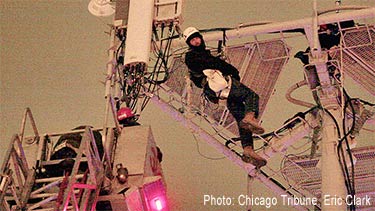 unnamed climber and his co-worker were performing maintenance on a cell tower at 77th and State streets when he fell off an antenna mounting frame after losing his footing. unnamed climber and his co-worker were performing maintenance on a cell tower at 77th and State streets when he fell off an antenna mounting frame after losing his footing.
Fortunately, practicing 100% tie-off saved the worker’s life. Firefighters responded to the call made by the man’s co-worker at approximately 6:15 p.m. and lowered him to safety with an aerial ladder truck.
The temperature at the time was approximately 34 degrees F.
Authorities neither released the man’s name, the company he was employed by nor the client they were performing services for.
|
New service unveiled on 10th Anniversary
Vendors, contractors and purchasers now have access to nation's most influential buyer's guide
November 18, 2014 – Following its 5th Anniversary in 2009, Wireless Estimator launched the Emergency Services Locator which is now used by the majority of  wireless contractors for daily job site documentation. wireless contractors for daily job site documentation.
Trying to top that safety resource’s huge success for our 10th Anniversary this year became a year-long work in progress, but we’re convinced we have, with the new Wireless Estimator Blue Book Buyer’s Guide being unveiled today.
Wireless Estimator introduced the industry to the first comprehensive online infrastructure buyer’s guide in 2004, but discovered over the years that advertisers wanted more visibility than just being provided with a logo and a sentence or two in a printed or digital directory.
Drawing together a focus group of industry advertisers, from small two-crew contractors to the nation’s leading and largest suppliers and service companies, Wireless Estimator was able to design a vendor and contractor resource that exceeded their five primary .jpg) requests: requests:
-
Provide multiple web pages with graphics and links so that visitors can learn about all of their company’s offerings and capabilities
-
Include the ability for employees with no web site design experience to easily build and maintain dynamic and professional looking content in an easy to use template-based administration program
-
Make the buyer’s guide easy for viewers to quickly identify their categories of interest and make the site’s navigation fast and easy, and available to viewed on a smart phone or tablet
-
Create greater visibility on the internet for their company through increased search engine optimization
-
Include a listing of all of the nation’s contractors employing elevated workers
We’re pleased that we were able to fulfill those requests and many more that were identified during a three-month beta test of the Blue Book.
You’ll want to bookmark the Blue Book for future reference to ensure quick access.
For additional information about the Blue Book Buyer’s Guide, click here.
Comments regarding the Blue Book can be addressed to BlueBook@wirelessestimator.com.
|
Safety lanyard monitoring system being developed is fleshed out in new forum release
November 4, 2014 – A Wireless Estimator Community Forum member posed the question, Could a safety lanyard monitoring system save lives?, and he received mostly a round of agreements; he also elicited from a Tennessee company that, not only could it reduce deaths, but one is in the works and might be in mostly a round of agreements; he also elicited from a Tennessee company that, not only could it reduce deaths, but one is in the works and might be in 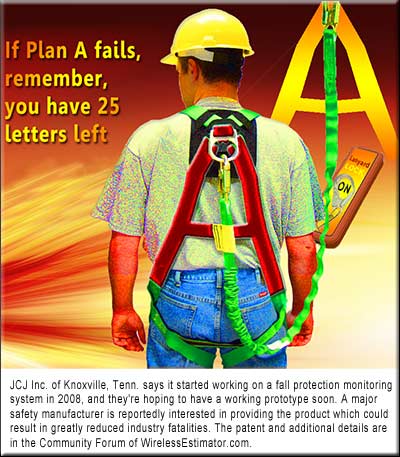 production next year. production next year.
Although the idea was briefly touched upon at last month’s OSHA/FCC tower climber safety workshop, this week’s posts in Wireless Estimator’s redesigned forum discuss the system in detail and provides the patent for the safety system owned by JCJ Inc. of Knoxville, Tenn. The company is reportedly in talks with a major safety manufacturer that might provide the system with their products.
JCJ is currently in the design and development stage of the idea that was germinated in 2008 following a number of years of high industry fatalities.
Inventors of the unit are William Flynt; Hillboro, N.H.; Shawn Remington, Oak Ridge, Tenn.; Jacob Martin, Oak Ridge, Tenn; and Timothy Vile, Rutland, Vt.
Wireless Estimator’s forum added new user tools to its forum last week to assist its growing community of posters. A separate registration from the one required for Wireless Estimator employment and other modules is required to post on the forum to accommodate many contributors whose companies prohibit them from using their work email address.
It also allows for an open exchange of constructive ideas without the contributor’s company or association being aligned with published comments.
|
Faux cell towers are real, but fake intercept cell towers prove to be phony
October 28, 2014 – America’s newest snipe hunt created by a market-savvy handset maker is inspiring residents to identify the fake spy vs. spy cell phone tower in their neighborhood. The media bought into it quicker than an ice bucket  challenge, and news outlets continue to contact Wireless Estimator to verify if those structures are real. Our reply: No, but yes, if you measure cell towers in eighths of an inch. challenge, and news outlets continue to contact Wireless Estimator to verify if those structures are real. Our reply: No, but yes, if you measure cell towers in eighths of an inch.
In early September, the story of fake cell towers being installed across the country received legs from a Popular Science article titled: “Mysterious Phony Cell Towers Could Be Intercepting Your Calls.”
Although the article did not show any photographs of actual cell towers, the media spiced up their rewrites of the Aug. 27, 2014 story with pictures of cell towers, from multi-carrier structures that would make a leasing representative drip with lust, to a TV broadcast tower clinging to its 600 MHz spectrum.
Even a Catholic online news site ran the story, inferring that their article on phony cell towers throughout the country was as close to 4G gospel as a parishioner could get, and ran a carousel of tower pictures to illustrate it.
Another news site used a photograph of a two-tenant faux pine tree to identify a fake tower, allowing for the presumption that an oily shadow industry of criminal collocations is sprouting up across America, but was hiding in plain sight.
The confusion began when Les Goldsmith, the CEO of ESD America, which sells the CryptoPhone 500, provided Popular Science with a map identifying where his $3,500 encryption handset found “17 different phony cell towers known as interceptors.”
“Interceptors look to a typical phone like an ordinary tower. Once the phone connects with the interceptor, a variety of over-the-air attacks become possible, from eavesdropping on calls and texts to pushing spyware to the device,” the article said.
The story never said that they were physical towers, but Goldsmith loved the misinterpretation by the media and let it play out before stating that a fake cell tower can be simply a laptop with two dongles plugged into it to give it GSM coverage.
But weeks later, ESD Director Buzz Bruner took a reporter along for a drive-by-test in Washington, D.C. and the resulting headline was: “Investigator Says He Found Multiple ‘Fake Cell Towers’ Near White House, Russian Embassy”.
In an interview with FOX Business commentator Stuart Varney, on Sept. 22, 2014, Bruner called the interceptors fake cell phone towers four times, as did Varney.
To shore up ESD’s waning 15-minutes of fame, Bruner, like Goldsmith, forgot to mention that the towers were capable of being no taller than a Monopoly thimble.
On Friday, a press request from a Midwestern daily newspaper asked if Wireless Estimator could provide photographs of “fake cell towers” for an article they were going to publish. It provided for an easy reply.
There are devices, such as Harris Corporation’s StingRay, which can mimic cell tower base stations and will force all nearby mobile phones and data devices to connect to it, whether or not you are on a call.
Known as IMSI-catchers (International Mobile Subscriber Identify), the equipment broadcasts a pilot signal that is either stronger than, or made to appear stronger than, the signals being broadcast by legitimate cell sites operating in the area.
Law enforcement agencies all over the country possess StingRays, though their use is often shrouded in secrecy. The ACLU has uncovered evidence that federal and local law enforcement agencies are actively trying to conceal their use from public scrutiny, and they are continuing to push for transparency and reform.
Some carriers are upgrading their network to a new encryption standard, called A5/3, that is more difficult to crack than A5/1.
However, industry security experts believe that the National Security Agency may still be able to eavesdrop on individual calls by manipulating a phone’s security settings directly, without having to crack the encryption.

|
MasTec's WesTower buy appears to have been prompted by a common thread: AT&T
October 21, 2014 – On the surface, MasTec’s announcement yesterday that it has acquired wireless infrastructure builder WesTower for $199 million appears to be a move by the Coral Gables, Fla.-based company to strengthen its branding and 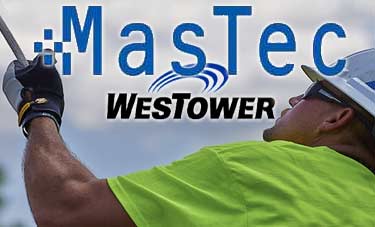 physical footprint throughout the nation, but a common thread for the deal seems to be three companies reacting to financial complications attributable to AT&T. physical footprint throughout the nation, but a common thread for the deal seems to be three companies reacting to financial complications attributable to AT&T.
In an analysts’ conference call this morning, MasTec CEO Jose Mas said that the deal made sense by allowing MasTec to expand its self-performing and contracting capabilities, and he inferred that MasTec was able to acquire WesTower at a fire sale price since the company has been struggling to capture its receivables from AT&T, which provides for approximately 70% of WesTower's revenues.
“It’s a very low risk deal. We’re getting the majority of the purchase price in acquired assets. So really, our at-risk capital is pretty limited in this deal and it’s why we like it so much,” said Mas.
MasTec's revenue from all of its business sectors for the year ended December 31, 2013 was $4.3 billion, a $.6 billion increase over 2012. In August, prior to the WesTower acquisition, the company estimated that their fiscal year 2014 revenue would be $4.4 to $4.5 billion.
“We’ve seen this movie before. Working capital challenges have been a significant problem for WesTower. Aside from the financial stress, not having the right processes consumes the organization. The business is forced to throw a significant amount of bodies at collections in an inefficient manner.”
“Rather than being able to focus upon growth and improving profitability, everyone’s job becomes about collections. We know we can fix that,” said Mas.
WesTower uses an accounting method called “percentage of completion,” where the company estimates, and then records, revenue and profit as a project continues, but before the bill is sent to the customer. Two of WesTower’s senior managers informed Wireless Estimator last month that they had recognized revenue on AT&T projects that the carrier may not pay for.
In addition, AT&T’s mid-May freeze of projects that weren’t shovel-ready affected WesTower’s cash flow and they began laying off workers, as did MasTec. Within six weeks the freeze shaved an anticipated $45-$50 million in revenues, according to Mas, and MasTec had to issue guidance to analysts.
The market wasn’t pleased with their warning, slicing their stock in almost half from an April 1, 2014 value of $43.42 to Oct. 14 at $22.56. Since then, based primarily upon the WesTower acquisition announcement, it was trading at $27.19 just before today’s close.
MasTec is banking on WesTower’s revenues shoring up its stock and is expected to present that case during its Q3 earnings call on Oct. 30, 2014.
In the transaction, according to a press release, MasTec acquired all of the issued and outstanding equity interests of WesTower for a one-time payment of approximately $199 million in cash. At closing, WesTower had approximately $159 million in tangible net worth, comprised mostly of working capital of $151 million, including approximately $18 million in cash.
WesTower saw red ink in 2013
WesTower’s parent company, Winnipeg, Canada-based Exchange Income Corp. (EI) acquired the company in 2011 for approximately $77 million U.S.
In 2013, WesTower lost an unknown amount of money and EI’s CEO, Mike Pyle, acknowledged that WesTower’s explosive growth had caused challenges in generating a return on investment.
He brought in a new senior management team and invested several million dollars to better manage the work being completed.
The company started to see some progress and WesTower returned approximately $15 million of EI’s $200 million of invested capital, according to financial filings.
But AT&T’s freeze reversed the company’s progress and WesTower needed to go back to EI for funding.
During a webcast this morning, Pyle said that WesTower put a serious drain on cash flow and profits when “you have half of your company contribute zero for 12 months.”
He said that MasTec contacted EI and the sale resulted in a profit for his company. EI also owns aviation companies and manufacturing plants, but Pyle said, “Our performance was too dependent on WesTower.”
In early July, when it became known again that WesTower was faltering due to AT&Ts freeze, one major analyst said it would severely affect EI’s income expectations, sinking the stock from July 7, 2014’s price of $22.02 (Canadian) to a low on Oct. 14 of $15.49. It recovered today to $19.10 following the deal’s announcement.
Pyle said that Peter Jeffrey, one of the original owners of WesTower, would remain as President of WesTower’s Canadian operations still owned by EI.
Part of MasTec’s success has been through buying underperforming companies, and Mas said that he believes the WesTower transaction will follow that model.
He said that the acquisition will provide significant geographic growth, identifying that the vast majority of WesTower’s business is in the Southwest and Western part of the country where MasTec has not been very strong.
Approximately 70% of WesTower’s business is where MasTec has limited or no business.
Mas said that WesTower’s capital for sales outstanding is approximately 40% higher than MasTec’s. He emphasized that there are some WesTower contracts that aren’t performing as well as they should, “so there are some chances that we will scale back in some areas and maybe even try to renegotiate or get out of some contracts.”
WesTower faced the challenges of significant growth, rising from about a $100 million in revenue in 2010 to approximately $450 million this year, Mas said.
“While their financial situation has been steadily improving , we believe we are in a far better position to make an immediate impact.”
He said that he didn’t envision any major changes in the near future. “We’re always going to be a mix of self-performing and contracting. I think it’s very important to have that mix in the business and I don’t think anything is going to be changed.”
|
Man jumps to his death from a tower on which a tech had jumped off in April
October 21, 2014 – With a suicide note left in his car, a Manchester, N.J. man jumped from a Long Branch 400-foot self-supporting tower in the city’s downtown 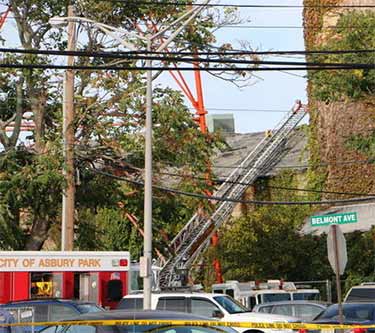 on Monday and died after crashing through an abandoned building at the Y107 tower site. In April, a tower technician also ended his life in the same manner. on Monday and died after crashing through an abandoned building at the Y107 tower site. In April, a tower technician also ended his life in the same manner.
Authorities said that Christopher Zweidinger, 38, was pronounced dead at the scene after he jumped from the tower
Police responded around 2:40 p.m. after receiving a call that someone was climbing the tower. The man, who was later identified as Zweidinger, was at about the 200-foot level when they tried to make contact with him using a loudspeaker.
He then removed his jacked and jumped and died on impact, according to authorities.
Zweidinger was the second person to leap from the tower this year. On April 21, 2014, a 60-year-old tower technician jumped to his death from the top of the tower and fell through the roof of the same vacant building where Zweidinger was found.
At that time the tech had attached his lanyard to the tower and remained there for a while, swinging from side to side as authorities tried to coax him down.
He then stared at the crowd which had gathered on the sidewalk outside a ring of emergency vehicles, unhooked his harness and threw himself off of the tower with his feet pointed at the ground and his hands raised in the air.
|
Media star Sarah Palin to deliver keynote address at NATE UNITE 2015 in Orlando
October 20, 2014 - The National Association of Tower Erectors (NATE) announced  today that Sarah Palin will deliver the keynote address at NATE UNITE 2015 in Lake Buena Vista, Fla. during the trade group’s conference Feb. 23, 2015 through Feb. 26, 2015 at Disney’s Coronado Springs Resort. NATE UNITE is widely regarded as the premier and most comprehensive educational event in the wireless and broadcast infrastructure industries. today that Sarah Palin will deliver the keynote address at NATE UNITE 2015 in Lake Buena Vista, Fla. during the trade group’s conference Feb. 23, 2015 through Feb. 26, 2015 at Disney’s Coronado Springs Resort. NATE UNITE is widely regarded as the premier and most comprehensive educational event in the wireless and broadcast infrastructure industries.
"It is my privilege to welcome Sarah Palin to NATE UNITE 2015,” stated NATE’s Trade Show Committee Chairman Aaron Pitts of P & D Antenna Service, Inc.
“Governor Palin has broken down barriers her entire life and will have a compelling personal story and inspirational message to share with NATE UNITE attendees based upon her accomplished background,” said Pitts.
Sarah Palin first made history in 2006, when she became the first female and youngest governor of Alaska. In 2008, Palin was chosen as Senator John McCain’s Vice Presidential running mate, becoming the first woman to run on the Republican Party’s presidential ticket.
After leaving office in 2009, Palin became a commentator for the Fox News Channel and published her autobiography, Going Rogue: An American Life. Palin was also named to TIME magazine’s “100 Most Influential People in the World” list. In 2010, she hosted the eight-week television series Sarah Palin’s Alaska on the TLC Network.
“We are excited to have Sarah Palin join us in February to help us celebrate NATE’s 20th anniversary,” said NATE Chairwoman Pat Cipov of Cipov Enterprises, Inc.
“Sarah Palin is a dynamic speaker and we are confident that NATE members will relate to her personal narrative of possessing a positive attitude, a relentless determination, an adventurous spirit and love of the outdoors,” said Cipov.
Registration for NATE UNITE 2015 is now open and accessible through the NATE website. Interested NATE members and industry stakeholders are encouraged to visit www.natehome.com
“NATE UNITE 2015 is shaping up to be the best event the Association has hosted in our 20 year history,” exclaimed NATE Board of Directors member Joel Hightower of Hightower Communications, Inc. “I encourage everyone involved in the diverse landscape of the wireless industry to make plans to attend today,” Hightower said.
|
Tower tech is shocked and burned when his measuring tape touches a high-tension power line
October 18, 2014 – A 22-year-old Lansing, Mich. tower technician was shocked and burned yesterday afternoon when a measuring tape he was using came in contact with a high-voltage power line adjacent to a self-supporting tower he was working on off of I-96 in Coopersville, Mich.
.jpg) The Ottawa County Sheriff’s Department said that Eric Davis was working at a height of approximately 100 feet when a wind gust caused his tape to touch the powerline at about 2:15 p.m. on Friday. The Ottawa County Sheriff’s Department said that Eric Davis was working at a height of approximately 100 feet when a wind gust caused his tape to touch the powerline at about 2:15 p.m. on Friday.
Had Davis not been tied off to the 273-foot-tall tower owned by American Tower Corporation, the incident would have most likely resulted in a fatality.
His co-workers, from Earthcom of Williamston, were able to quickly get Davis down the tower where he was immediately treated by arriving firefighters from Coopersville-Polkton.
Davis was transported by ambulance to Spectrum Health Butterworth Hospital in Grand Rapids for further treatment.
Earthcom's crew was working on a T-Mobile project when the incident occurred.
The power lines of unknown voltage run parallel to the tower compound and across I-26.
OSHA regulations under 1926.1408 set forth the distance that a crane or derrick must be from a power line.
Regarding individuals, their best safety practice guideline for working near overhead power lines is: “Employees shall not be permitted to approach or carry any conductive object closer than 10 feet to an energized line.”
They do provide an exception, however, for trained and qualified employees using insulated tools designed for high voltage lines.
OSHA has cited companies in the past for exposing workers to electrocution hazards when they are working in close proximity to energized parts without approved insulating safeguards.
Some companies require the use of non-conductive fiberglass measuring tapes whether or not employees are working around power lines.
|
Pervasive free-climbing seen as a top concern by OSHA/FCC working group addressing fatalities
October 17, 2014 – A workshop on tower climber safety and injury protection  presented by the Federal Communications Commission and the Department of Labor’s Occupational Safety and Health Administration on Tuesday in Washington, D.C. had two panels of speakers exploring issues as divergent as their backgrounds, but there was a commonality of presented by the Federal Communications Commission and the Department of Labor’s Occupational Safety and Health Administration on Tuesday in Washington, D.C. had two panels of speakers exploring issues as divergent as their backgrounds, but there was a commonality of 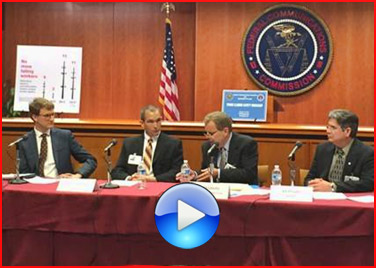 purpose amongst all panelists: America needs to move quickly to reduce and eliminate injuries and fatalities in the wireless construction industry. purpose amongst all panelists: America needs to move quickly to reduce and eliminate injuries and fatalities in the wireless construction industry.
Following his opening remarks, Assistant Secretary of Labor for OSHA David Michaels welcomed and embraced Kathy Pierce after she walked up to the podium with emotional assistance from her daughter.
To Kathy’s right was a poster that identified how the number of tower climber fatalities had spiked within the past two years, with 11 deaths already happening this year, a sad and ever-present reminder that number four was her son, 21-year-old Chad Weller, who died on March 19, 2014 while working in icy conditions in Maryland on top of a water tower.
Kathy shared her unfortunate and compelling story that attached the repeated failings of construction companies and workers to the conscience of everyone in attendance as she closed with: “As a grieving mother, I plead that we all unite together to make a difference in this industry.”
It set the tone and urgency for the workshop’s panelists and the industry at large to explore factors contributing to the high rate of injuries and fatalities, and what best practices should be put in place to ensure tower climber safety.
The panel sessions, designed to provide the framework for future collaborations, discussed numerous topics from pervasive free climbing to the possibility that emerging standards might be in conflict with each other if associations don’t work closer together while preparing them.
Providing a detailed postmortem analysis of fatalities and injuries was suggested by panelists as a way to better understand why incidents occur and how the underlying influences can be mitigated.
Labeling it a “sign-before-you-climb” document, the need for a job safety analysis form on every work site was emphasized by FCC Commissioner Mignon Clyburn.
A study of hundreds of injuries and many fatalities by Zurich, the nation’s largest insurer of telecom companies, was presented which identified that there were four commonalities: 4. Short tenure with an employer; 3. Remote locations with low supervision; 2. Younger employees; and 1. Untrained workers.
The workshop and the government’s continuing efforts to address climber education and safety is the first-ever partnership between OSHA and the FCC.
Collaboration to continue with recommended practices
In a joint announcement on Wednesday, Secretary of Labor Thomas Perez and FCC Chairman Tom Wheeler said their agency’s partnership will continue with a joint working group the FCC and DoL have decided to form, with industry participation, to develop recommended practices for employers.
The first panel discussion, Diagnosing the Problem: Causes of High Fatality and Injury Rates, included Dave Anthony, Shenandoah Tower Service; Liz Day, City University of New York; Bridgette Hester, Hubble Foundation; and Wallace Reardon, Workers at Heights Health and Safety Initiative. Moderators were Chad Breckinridge, Associate Bureau Chief, WTB, FCC, and Jessica Douma, Regulatory Analyst, OSHA.
Implement the Solutions: Identifying and Adopting Best Practices, the second panel, had panelists Jonathan Campbell, PCIA; John Johnson, Black & Veach; Craig Lekutis, WirelessEstimator.com; Art Pregler, AT&T; Paul Roberts, American Tower Corporation; and Todd Schlekeway, NATE. Moderators were Michael Janson, Legal Advisor, WTB, FCC, and Jim Maddux, Director, Directorate of Construction, OSHA, DOL.
The event’s panel presentations as well as discussions by government leaders and the TIRAP signing ceremony can be viewed here.
|
|
Technicians to be first at bat
TIRAP to elevate tower techs' industry standing with unified training and national certification
October 15, 2014 – A powerful consortium of telecommunications companies and industry associations have joined with the U.S. Department of Labor (DoL) and the Federal Communications Commission (FCC) in forming a public-private partnership 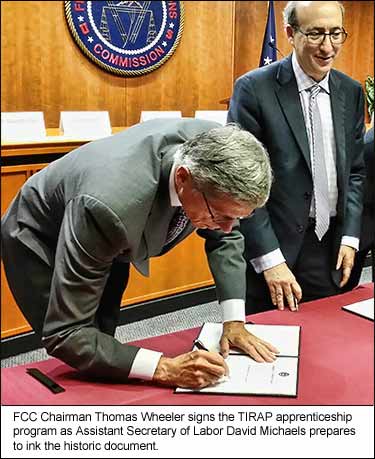 aimed at developing apprenticeships to improve workplace safety, address industry workforce needs, and provide workers with greater employment and advancement opportunities. aimed at developing apprenticeships to improve workplace safety, address industry workforce needs, and provide workers with greater employment and advancement opportunities.
Known as TIRAP, the Telecommunications Industry Registered Apprenticeship Program, the joint venture will develop DoL-credentialed apprenticeship programs for the training and career development of the telecommunications industry workforce.
TIRAP marks the first time that multiple industry stakeholders have combined efforts to create an apprenticeship program that wireless infrastructure companies can implement voluntarily and cost-free to enable employees to cultivate key skills through  education and on-the-job training (continued). education and on-the-job training (continued).
Please see:Technical proficiencies will now be validated
|
Anti-siting community will be expected to run with poor RF safety report card
Commentary
October 6, 2014 – An article in The Wall Street Journal, entitled “Cellphone Boom Spurs Antenna-Safety Worries,” will most likely become the newest anti-tower template at siting application hearings with protestors purposely sidestepping the included statement that “The [radio frequency] power isn’t considered harmful by 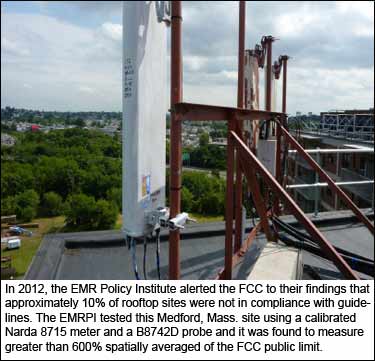 the time it reaches the street, but it can be a risk for workers and residents standing directly in front of an antenna.” the time it reaches the street, but it can be a risk for workers and residents standing directly in front of an antenna.”
In the Oct. 2, 2014 WSJ article it was identified that one in 10 sites violates federal rules for marking and barricading locations that can be a risk for workers and residents standing in front of them.
Not understanding that there is a significant difference between a cell site and a tower site, and that the sites tested were primarily rooftops, cut and paste news aggregators ran with their own more titillating headlines such as: “One in 10 Tower Sites Violates Federal Radio Frequency Rules.”
The article’s compliance findings were based on data from professionals such as Richard Tell, a well-respected industry RF engineer.
Although the EMR Policy Institute came up with the same 10% out of compliance findings over two years ago and alerted the Federal Communications Commission’s enforcement chief, the agency took no discernable action.
But the WSJ has juice in Washington and this time the FCC might follow through with enforcement action.
After a WSJ reporter informed T-Mobile that one of their cell sites in Arizona, painted brown to match a fence, with lawn chairs in front of it, showed emissions above safety guidelines, the carrier scrambled to install warning signs and rope off a patch in front of the antenna with a chain.
Carriers and site management companies state that they take public safety very seriously, but will not address why there is a high out of compliance rate. Representatives from two major U.S. tower owners informed Wireless Estimator that they would not comment on the WSJ’s findings.
Protecting tradesmen is a national concern since third party workers on rooftops are not being provided RF radiation training and they are largely uninformed of RF radiation emissions and the risks they pose – and it needs to be addressed.
What the industry doesn’t need is a national hysteria that one cell “tower” out of every 10 is unsafe, and additional safeguards need to be explored and put in place by local or state agencies.
The FCC is responsible for regulating RF emission for licensed carriers and the federal Telecom Act of 1996 prohibits any other government agency from further regulating sites.
In 2009, City Councilman Vincent Gentile led a failed attempt to require New York City to monitor radiation from cell antennas.
Lawrence Behr, CEO of LBA Group, said at that time the proposed legislation was “scientifically naïve and quite impractical to implement.”
The conundrum, however, is the agency tasked with monitoring RF compliance of cell sites admits that it’s a paper tiger and lacks the resources to ensure that carriers are compliant. In the past 18 years since the telecom act was adopted the FCC has only issued two citations, according to the WSJ.
As small cells and DAS continue to porcupine public pathways, safe RF emissions and enforcement should become a top priority of the FCC.
|
Live webcast will be available
Washington chiefs to tackle rising tower climber deaths at October workshop
October 3, 2014 – High ranking government officials will be meeting with wireless industry executives on Oct. 14, 2014, at FCC Headquarters in Washington, D.C. to examine the causes of high fatality and injury rates in the wireless construction .jpg) industry, and to identify best practices that have worked and how to implement them. industry, and to identify best practices that have worked and how to implement them.
They’ll also be examining methods for addressing specific risks and potential safety system failures as part of the Federal Communications Commission’s and Department of Labor’s efforts to reduce deaths and injuries that have risen as the nation builds out its wireless network infrastructure.
Attending the session will be Thomas E. Wheeler, FCC Chairman; Thomas E. Perez, Secretary of Labor; and Dr. David Michaels, Assistant Secretary of Labor for Occupational Safety and Health.
The workshop’s first panel discussion, Diagnosing the Problem: Causes of High Fatality and Injury Rates, will include Dave Anthony, Shenandoah Tower Service; Liz Day, City University of New York; Bridgette Hester, Hubble Foundation; and Wallace Reardon, Workers at Heights Health and Safety Initiative. Moderators will be Chad Breckinridge, Associate Bureau Chief, WTB, FCC, and Jessica Douma, Regulatory Analyst, OSHA.
Implement the Solutions: Identifying and Adopting Best Practices, the second panel, will have panelists Jonathan Campbell, PCIA; John Johnson, Black and Veach; Craig Lekutis, WirelessEstimator.com; Art Pregler, AT&T; Paul Roberts, American Tower Corporation; and Todd Schlekeway, NATE. Moderators will be Michael Janson, PhD, Legal Advisor, WTB, FCC, and Jim Maddux, Director, Directorate of Construction, OSHA, DOL.
There will also be a signing ceremony for the Telecommunications Industry Registered Apprenticeship Program (TIRAP) with Scott Kisting, TIRAP Chairman, and Jonathan Adelstein, President, PCIA, and Former FCC Commissioner.
The workshop is free and open to the public. Attendees do not need to pre-register. The FCC will webcast the workshop on the FCC webpage. The webcast may be viewed at http://www.fcc.gov/live . Viewers may submit questions during the workshop via email at livequestions@fcc.gov and on Twitter using the “#climbersafety” hashtag.
For additional information about the workshop, click here.
|
Intentional calls regarding a tower tech's death highlights troubling social media abuse
September 30, 2014 – Social media, more predominately Facebook in the wireless construction industry, has become an excellent and almost necessary platform for companies to get their message out. It’s also a great vehicle for workers to share information and friendship, especially for tower technicians who frequently cross paths across the nation. It’s also a tool for intentional misinformation bordering on criminal behavior.
.jpg) On Saturday, a post on one of the 27-plus tower industry groups identified that a technician had fallen to his death the previous evening. It quickly gained legs and appeared on individual Facebook timelines, and a number of emails were sent to Wireless Estimator requesting additional information about what appeared to be the 10th fatality in 2014. On Saturday, a post on one of the 27-plus tower industry groups identified that a technician had fallen to his death the previous evening. It quickly gained legs and appeared on individual Facebook timelines, and a number of emails were sent to Wireless Estimator requesting additional information about what appeared to be the 10th fatality in 2014.
The good news is that a death did not occur on Friday. The distressing news is the rumor has been determined to be an effort by an individual, possibly an employee, to impugn an established multiple-office service contractor’s excellent safety program and industry standing, according to a spokesperson from the affected company.
Wireless Estimator’s policy is to follow up on professional news articles and TV reports of serious injuries or fatalities to provide additional details and clarity to press reports that are oftentimes erroneous due to the reporter’s or investigating authority’s lack of industry knowledge.
The news site also investigates reports of fatalities that have not been covered in the media, but have in fact happened, while allowing all background providers to remain confidential.
Following Friday’s Facebook post, Wireless Estimator interviewed three individuals claiming to have knowledge of the fatality.
The information they provided, from a foreman who had contacted them, was so detailed and credible that it appeared that there was clearly a fatality.
Reportedly happening in Georgia, they said the fatality occurred when a technician was swapping out a faulty remote radio unit at approximately 10 p.m.
They provided his first name, but could neither pronounce nor spell his last name. They knew he was Russian and his family had not been notified. The man was part of a tiger team. Carrier identification was provided along with the management OEM that called the crew out for the troubleshooting event. The deceased’s employer was also named as well as his foreman.
And intimate details were provided about the tech and his last moments in life.
“He finished weatherproofing the RRU, de-rigged the tower and radioed on his two-way that he was coming down. It couldn’t have been but a few seconds later that the foreman heard some clinging and clanging and then saw [name] on the ground,” said one industry worker who had been provided this information.
Another worker repeated a similar scenario and said he was informed that OSHA was called and was on site investigating the fatality. His voice tremored as he discussed the details about the deceased climber, an individual that he had known.
Yesterday, Georgia’s three OSHA area offices said that they had no knowledge about a fatality involving a telecommunications company. Since the death was said to have occurred near the Tennessee border, TOSHA was contacted and a spokesperson said that the incident had not been reported to the state agency.
While returning on a flight home last night, the named employer’s Vice President of Operations contacted Wireless Estimator and said that it was incredulous that an individual would provide this false accusation and his company would be exploring all options to address it, including legal action.
He said that his firm takes pride in its excellent safety record and their company-wide culture of embracing safety at all times.
His company’s HR representative had earlier informed Wireless Estimator that although they did have an employee with the tower foreman’s name that was supposed to have witnessed the falling of another employee, the company had not experienced a workplace fatality.
In a scheduled email newsletter to its employees and others within the industry yesterday, the company highlighted its participation and awards in their ongoing 100% Tie-Off 24/7 campaign.
It also said, “As a company, we realize social media is a great way to raise awareness about who we are, what we provide and the many opportunities we have available,” and asked readers to like them on Facebook.
Sadly, it appears that one very troubled individual took an opposite approach.
|
Federal flogging of a Missouri tower contractor is OSHA's warning that they've had enough
September 27, 2014 – In advance of a joint OSHA / FCC workshop on Oct. 14, 2014 in Washington, D.C. regarding tower climber safety and injury prevention, OSHA has delivered a public flogging and a $134,400 fine to a St. Peters, Mo. tower contractor following the death of two of its workers after two towers collapsed in Blaine, Kan.
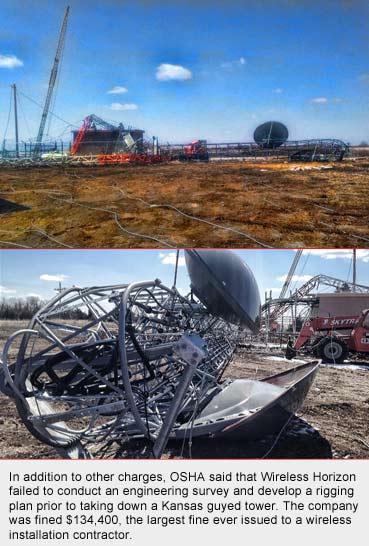 OSHA also placed the installation contractor, Wireless Horizon Inc., on the Severe Violator Enforcement Program (SVEP) following the incident as well as citing them for two willful and four serious safety violations. SVEP has been identified by a number of industry observers as being essentially a blacklist that could cripple a company’s revenue streams and put them out of business. OSHA also placed the installation contractor, Wireless Horizon Inc., on the Severe Violator Enforcement Program (SVEP) following the incident as well as citing them for two willful and four serious safety violations. SVEP has been identified by a number of industry observers as being essentially a blacklist that could cripple a company’s revenue streams and put them out of business.
"Two families have lost their loved ones in a preventable tragedy. No one should ever have to endure that loss. Inspecting and ensuring equipment is in good working order is a common-sense safety procedure that stops injuries and fatalities," said Dr. David Michaels, assistant secretary of labor for occupational safety and health in making the citations announcement that castigated the contractor.
"OSHA expects tower owners and operators, such as Wireless Horizon, to protect their workers on job sites in this hazardous industry by increasing training and implementing all known safety precautions. Our nation's growing need for telecommunications should not cost workers their lives."
Dr. Michaels has made it clear in recent statements that he is concerned about the high fatality rate within the wireless construction industry and will be attacking it on multiple fronts to reduce deaths. Please see: Citing Wireless Horizon was a down-to-the-wire decision
|
Close to 2,000 towers affected
Techs warned not to climb a tower until possibly faulty safety climbs are identified and isolated
September 19, 2014 – Fall protection equipment provider Capital Safety has issued a request for tower climbers to check a structure’s safety climb system prior to  ascending the tower after a number of reports were received by the company that the cable had slipped from the carrier clamp in the top bracket assembly of DBI-SALA systems purchased from Capital Safety between Sept. 1, 2013 through May 13, 2014. ascending the tower after a number of reports were received by the company that the cable had slipped from the carrier clamp in the top bracket assembly of DBI-SALA systems purchased from Capital Safety between Sept. 1, 2013 through May 13, 2014.
.jpg) A company spokesperson said that he believes that there may be up to 2,000 affected wireless communications structures. A company spokesperson said that he believes that there may be up to 2,000 affected wireless communications structures.
Prior to the release of Capital Safety’s product safety notice today, Nate Damro, Vice President of Global Marketing for Capital Safety said, “We have received a small number of recent reports and we continue to work on confirming these reports.”
Damro said that Capital Safety is still working to confirm details of each incident. “We have one report of a worker on the tower at the time of separation,” he said.
The safety notice concerns the DBI-SALA Lad-Saf Flexible Cable Ladder Safety System. The company states that although their top bracket design has been used in the market for more than 40 years without incident, the reported slippage raises the potential for injury to users of the affected systems.
Capital Safety emphasized that the notice is not a recall and does not apply to Capital Safety’s 1x7 strand system. The system in question utilizes 7x19 strand cable.
If an affected safety climb system is found, the company is warning climbers not to use it and the tower’s owner should contact Capital Safety’s customer service department at 800-328-6146 and they will provide repair guidance.
Although a tower technician can identify whether the strand cable is the affected 7x19, it would be difficult for them to assess whether the unit was purchased between Sept. 1, 2013 and May 13, 2014.
Damro said the system does come with a plate label that attaches to the ladder or tower. The plate has an area for inspection dates and clearly states DBI-SALA on it. However, the inspection dates may not be indicative of the purchase date.
“Outside of that, the tower owner should have records of the system and date of purchase,” said Damro.
Paul A. Roberts, Vice President, Compliance, of American Tower Corporation, said that once they learned of this potential issue, they immediately took action and identified about 10 sites where such devices were located.
“Until they are fixed or replaced, no work will be done on these locations. We have a strong safety program and will take all necessary steps to ensure these devices are fixed,” he said.
“We are working with companies that have affected towers to get them fixed and reported as soon as possible. We are supporting the tower owners as they request additional signage for their towers,” Damro said.
SBA Communications Corporation is in the process of providing due diligence to identify affected towers in their portfolio and believe that the total might be approximately 70 structures.
“We’re in the process of tagging the climbing system on those towers,” said David Sams, Vice President of Risk Management for the Boca-Raton, Fla.-based tower owner.
“I know Capital has mentioned that they’re going to do repairs to the system. We’re not going to take that ultimate risk with personnel fall arrest systems on our sites. We’re going to replace them,” said Sams.
Crown Castle International, the nation’s largest tower owner, did not respond to a request for information regarding their plans to mitigate potential problems with the safety climb systems.
Capital Safety has not identified when they first became aware of the cable slippage problem, but documentation reviewed by Wireless Estimator shows that they had prepared a safety alert and inspection protocol on Aug. 8, 2014.
|
Ham radio operator succumbs after 90-foot fall
September 17, 2014 - A Silent Key announcement, in remembrance of a deceased ham radio operator, was sent out this morning after authorities announced that last 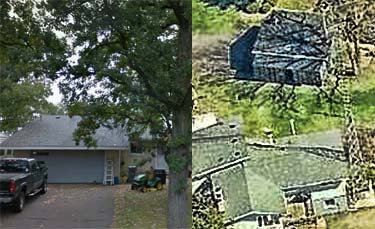 night an Eau Claire, Wis. man fell to his death from a 100-foot tower in Eagle Point while performing maintenance on the self-supporting structure. night an Eau Claire, Wis. man fell to his death from a 100-foot tower in Eagle Point while performing maintenance on the self-supporting structure.
Although he was wearing a safety harness he was not tied off, according to Chippewa County Sheriff Jim Kowalczyk.
Kowalczyk said James G. Linstedt, 59, (W9ZUC) was on the tower performing maintenance at approximately the 80-90-foot level of the tower located at 8121 163rd Ave., Eagle Point at the home of former Chippewa County Sheriff Ron Anderson,
Anderson and Linstedt were friends and ham radio operators.
The accident happened around 6 p.m. Linstedt was pronounced dead at Anderson’s residence.
Kowalczyk said Linstedt was a high school classmate of his, and called him a "very intelligent guy."
|
Authorities checking to see if T-Mobile cell site in New Jersey started building fire
September 16, 2014 – Authorities are looking into the possibility that a three-alarm 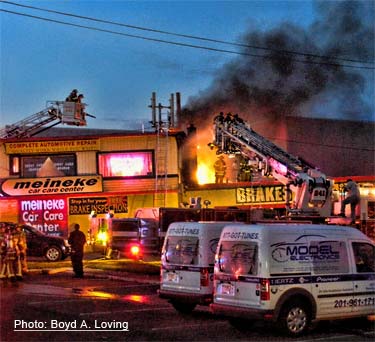 blaze on the top of an auto repair business last night might have been started by an electrical fire originating from a T-Mobile cell site on the building located in Ramsey, N.J. blaze on the top of an auto repair business last night might have been started by an electrical fire originating from a T-Mobile cell site on the building located in Ramsey, N.J.
While extinquishing the fire a firefighter suffered a shoulder injury and was transported to a local hospital.
Firefighters battled the three-alarm blaze on the second floor and roof of a Meineke Car Care Center at 536 Route 17 after the fire was called in at 7:00 p.m.
One Mahwah firefighter suffered a shoulder injury and was transported to Valley Hospital in Ridgewood. Firefighters from Allendale, Wyckoff and Ho-Ho-Kus also were at the scene of the fire.
 One woman, a Meineke employee, was in the building when the fire began but was outside by the time firefighters arrived. The fire was under control by 8 p.m. One woman, a Meineke employee, was in the building when the fire began but was outside by the time firefighters arrived. The fire was under control by 8 p.m.
It is a rare occurrence for a fire to start in a cell site equipment room or from transceivers placed on rooftops. Fires inside a monopole are a more frequent problem as carriers weld upon the structures to increase tenant capacity.
On Saturday, a monopole, at right, caught fire in Thurston, Ore. Officials did not respond to requests by Wireless Estimator as to the cause of the fire or the structure’s owner.
|
Tower lamping requirements were observed, but insurers agree to a $6.7 million death settlement
September 15, 2014 – Constructing towers just shy of 200 feet in height to avoid the cost of installing, monitoring and maintaining obstruction lighting, as required by federal regulations if the structure is higher, is a common and legal industry 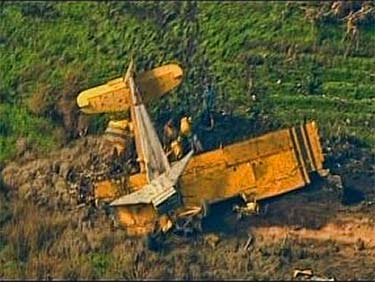 practice. However, a recent wrongful death insurance settlement of $6.7 million has one trade group advocating for its agricultural pilots that all heights of meteorological towers should be lamped. practice. However, a recent wrongful death insurance settlement of $6.7 million has one trade group advocating for its agricultural pilots that all heights of meteorological towers should be lamped.
Sacramento, Calif. attorney Roger Dreyer won the settlement earlier this month in a wrongful death lawsuit filed on behalf of the family of an agricultural pilot who lost his life when he flew into an unmarked tower in 2011. The lawsuit was filed in 2012.
Pilot Steve Allen was hired by Bouldin Farming Co. to spread winter wheat on Webb Tract Island in Contra Costa County on Jan. 10, 2011 when he struck a tower that was installed to monitor wind levels to gauge the potential for a wind energy farm on the land. The 58-year-old aviator was killed in the crash.
 The tower was built to stay under 200 feet, which would have triggered federal regulations that require towers to be marked so they are visible to low-flying planes, the lawsuit alleged. The tower was built to stay under 200 feet, which would have triggered federal regulations that require towers to be marked so they are visible to low-flying planes, the lawsuit alleged.
The case sets a standard in the agricultural and meteorological tower community, Andrew Moore, executive director of the National Agricultural Aviation Association, said in a news release. “Now those individuals who lease land for the use of meteorological evaluation towers and wind-energy investors will have to recognize that the standard for them is to mark these towers and obstructions so that agricultural aviators will be aware of their presence and avoid them accordingly.”
According to Moore, strobe lighting, painting and other visible markings along with databases showing exact geographical locations of these towers are some of the proper safety standards that should be used to protect agricultural aviators from low-level towers.
No amount of money will compensate the Allen family for their loss, Dreyer said in a news release, but his legacy will be an effect on the industry he loved. Dreyer said he hopes the wind, agricultural and tower manufacturing businesses will change their practices.
Dreyer said the tower was manufactured by NRG Systems Inc. It was installed by Echelon Environmental Energy and PDC Corp., which had been hired by Renewable Resources Group. The group was an agent for ZKS Real Estate Partners and Delta Wetland Properties to monitor wind levels on Webb Tract. All of the above defendants, through their insurance carriers, contributed to the $6.7 million settlement that was reached shortly before the lawsuit went before a jury trial.
A compliance officer of a major tower owner, who requested to remain unnamed, said that although he was saddened by the pilot’s passing, he stated that Moore’s inference that there was a new standard that should be followed was incorrect.
“Only the FAA can set policy for new or revised lighting standards,” he said.
He also stated that providing obstruction lighting on a low height tower could mislead other pilots to believe that they are at a higher elevation than they actually are.
Another pilot was killed when his crop dusting airplane hit a temporary meteorological tower on Aug. 5, 2013 in Balko, Okla.
In its final report on the crash released in March, the National Transportation Safety Board blames the pilot and the sun for a crash in which he died last August.
The NTSB said the probable cause was the pilot's failure to stay clear of the tower and a contributing factor was the sun's glare. The NTSB said a witness reported that the pilot had flown past the tower several times that day, but on the fatal flight the sun was behind and just to one side as he approached it.
The NTSB stated that the incident demonstrates how dangerous temporary meteorological towers can be, but they offered no suggestions as to how to ensure greater visibility.
|
A $400,000 donation buoys the launch of the Tower Family Foundation at CTIA
September 11, 2011 - Maya Angelou said, “I’ve learned that you shouldn’t go through life with a catcher’s mitt on both hands. You need to be able to throw 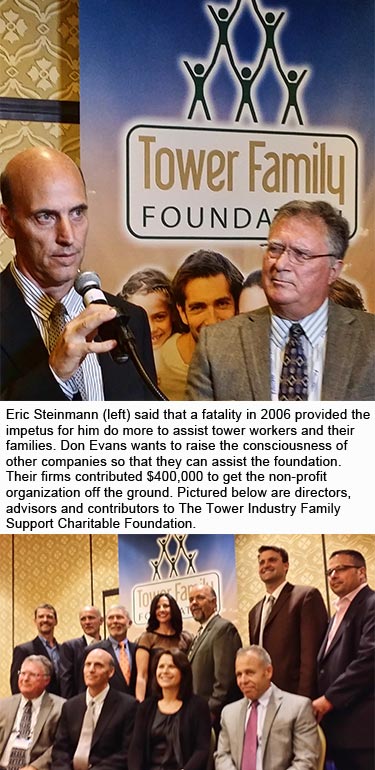 something back.” something back.”
Two wireless executives personified the late celebrated poet’s message yesterday evening when it was announced at CTIA’s Super Mobility Week in Las Vegas, Nev. that their $400,000 donation to the Tower Industry Family Support Charitable Foundation would help provide financial assistance to family members of severely injured, permanently disabled, or deceased tower workers.
“ClearTalk Wireless and Fletcher, Heald and Hildreth, LLP are passionate about helping tower workers and their families who have been impacted by a post-accident or fatality situation,” said ClearTalk and FHH representatives Eric Steinmann and Don Evans in a statement released at a press reception.
“These grief-stricken families are often left with no means of support and we have always tried to help when we hear of these situations,” Steinmann and Evans added.
The 501c-3 non-profit Foundation was formed after Steinmann and Evans approached officials from the National Association of Tower Erectors with their desire to give back to the men and women in need who have been injured while building and maintaining the nation’s wireless networks.
Although a number of NATE members sit on the foundation’s board of directors and advisory committee, Foundation President Jim Tracy, CEO of Legacy Telecommunications, Inc, emphasized that membership in the trade group is not a requirement to qualify for support or a scholarship.
In opening remarks, Tracy said that although people will frequently look up to emergency workers due to their heroic efforts, unsung heroes are oftentimes the wireless workers who are at the forefront of ensuring that the nation’s networks are operational at all times, especially following natural disasters.
“ClearTalk Wireless and Fletcher, Heald and Hildreth, LLP are leaving a lasting legacy through their commitment to help establish the Tower Industry Family Support Charitable Foundation,” said Tracy.
Steinmann and Evans said that NATE is the organization that has advocated for safe industry practices since their inception 20 years ago and they were excited to partner with the organization in order to establish the foundation.
“We are encouraging the entire industry to help us spread the word about the resources the organization has available and to nominate tower workers and/or their families who have been affected by an on-the-job accident situation,” said Advisory Committee member Victor Drouin, President of Green Mountain Communications, Inc.
Tracy said that the advisory committee will evaluate all applications for accidents that occurred on or after September 1, 2014.
Steinmann, CEO of ClearTalk, who has successfully built out and operates networks running on spectrum purchased through FCC auctions, said that he was impelled to reach out to the industry after seeing how a technician’s family had to struggle following his death when he fell from a tower.
He said that after an accident on another wireless provider’s tower site in 2006, a year in which there were 19 fatalities, he got in touch with the deceased’s family and helped them where he could, but knew that he had do more.
Evans, whose legal firm has worked with Steinmann’s company for many years, said that in his time as a telecommunications attorney, towers often were just information on paper, but that in working with NATE, he came to appreciate the dangers a tower technician is exposed to on a daily basis.
Evans said that he hopes other people in Washington will have their consciousness raised by the foundation’s work.
Evans and Steinmann had requested that the traditional handing over a blackboard-sized check not be part of the press conference, according to a foundation member familiar with pre-event planning.
“They truly wanted to stay out of the limelight and wanted the focus to be upon getting other companies to understand the need to support this worthy cause, especially the major carriers who are the primary beneficiaries of our industry’s efforts,” he said.
Interested stakeholders are encouraged to visit the Tower Industry Family Support Charitable Foundation’s website at www.towerfamilyfoundation.org to learn more about the organization, make an online contribution or complete an official nomination application form.
|
Two tower techs released from hospitals, but third crew member is still critical
Update: September 4, 2014 - An OSHA spokeswoman said the agency is investigating Tuesday’s accident that injured three tower technicians in Norman, 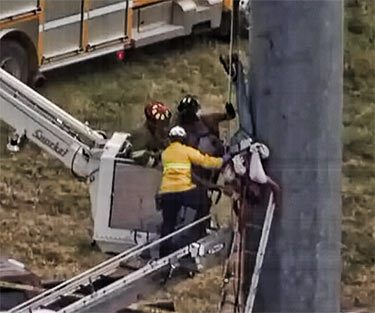 Okla. while they were working on a 190-foot monopole owned by Dragon Communications of Oklahoma City. Okla. while they were working on a 190-foot monopole owned by Dragon Communications of Oklahoma City.
One of injured workers, Don Buffarini ,was treated and released from Norman Regional Hospital and Josh Harjo was discharged from OU Medical Center.
Lucas Mullins, 19, who entered the tower climbing profession in May, however, is still in critical condition, according to his mother, Cheri, but she said there have already been several encouraging signs that he will continue to improve, and she and her family believe that the power of prayer will help him heal.
Mullins, according to an eyewitness, became unconscious when something struck him in the head at about the 120-foot level . When a fellow technician attempted to bring him down, their controlled descent failed and they fell quickly to the 20-foot level.
According to a family member, from information she had been told, the only thing stopping the technicians from certain death was a safety cable that got tangled in their legs on the way down.
Another eyewitness said that when the men fell, just before their fall was arrested, they hit a third coworker who was beginning to climb the tower.
It is not known who contracted the men to work on the single tenant tower. They were reportedly employed by Tower Services, Inc. of Edmond, Okla. The company did not reply to a request by Wireless Estimator for additional information.
- - - - - - - - - - - - - - - - - - - - -
Update: September 3, 2014 - Although their employer has not been verified, the victims involved in Tuesday’s accident on a monopole site have been identified.
Don Buffarini was treated and released from the hospital.
The two other technicians have also been identified as Josh Harjo and Lucas Mullins. Mullins remains in critical condition at an Oklahoma City hospital.
It is not known if it is the same individual, but a Josh Harjo has a Facebook page and it states that he is employed by Tower Services, Inc. of Edmond, Okla.
- - - - - - - - - - - - - -
September 2, 2014 – A tower technician has received life-threatening injuries after passing out and possibly being injured while he was being rescued from a 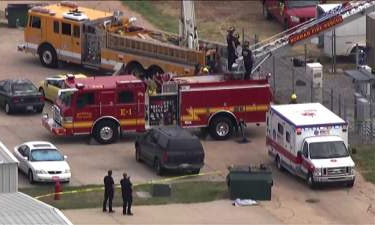 monopole he was working on in Norman, Okla. His co-worker was also injured while bringing the him down too quickly, according to authorities. monopole he was working on in Norman, Okla. His co-worker was also injured while bringing the him down too quickly, according to authorities.
About 10:45 a.m., Norman fire crews were called to a cell tower near North University Blvd. and Highland Pkwy. with reports that a man was unconscious on a monopole about 120 feet from the ground, said Deputy Fire Chief Jim Bailey.
Bailey said that when crews arrived at the scene, three tower technicians were on the cell tower. One of the men was assisting the injured co-worker and the third man was closer to the ground, according to Bailey.
The tower tech that was higher up connected himself to the injured man and performed a rescue procedure that allowed him to lower the man to the ground.
However, Bailey said, they descended too rapidly and both of the men slammed into the tower. They hit the tower level where the third man was, about 20 feet from the ground, Bailey said, and fire crews were able to rescue all three men from that level.
The injured tower tech and his rescuer were taken to OU Medical Center with potentially life-threatening injuries, Bailey said. The third man was taken to Norman Regional Hospital.
"One lost a tremendous amount of blood," Bailey said, explaining why crews were spraying down the area with fire hoses.
Brian Menke, who owns The Auto Spa near the tower, said he watched the accident and rescue unfold, and said that something dropped and struck the one technician on the head.
“The other rigger was trying to help him as nothing the fire department had would come close to reaching. As the other rigger was assisting his friend they both fell. Stopping about 20 feet from the ground. There’s so much blood everywhere, on cars, on buildings, on me. I heard them yelling, his convulsing and losing color before police/fire was even there,” said Menke on his Facebook page.
The injured workers, their employer and the tower’s owner were not immediately available. Wireless Estimator will provide additional information as it becomes known.
|
Services set for two techs killed while
they were securing reels on a trailer
August 31, 2014 – Services have been set for two tower technicians who lost their lives in a tragic roadside accident on Tuesday in Newcastle, Okla. Authorities said 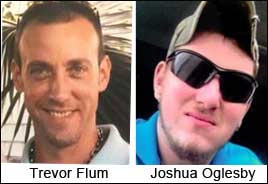 that Joshua Oglesby, 22, and Trevor Flum, 37, were off the side of H.E. Bailey Turnpike with their vehicle when a man driving a red pickup truck crashed into the MUTI trailer, killing both men. that Joshua Oglesby, 22, and Trevor Flum, 37, were off the side of H.E. Bailey Turnpike with their vehicle when a man driving a red pickup truck crashed into the MUTI trailer, killing both men.
According to MUTI Senior Vice President Scott Kisting, the two men, along with a third member of a MUTI crew were transporting materials to a job site.
While traveling down the expressway, they observed that one of the rigging straps appeared to be working loose on the reels of which they were hauling and determined that they would need to stop and further secure the load.
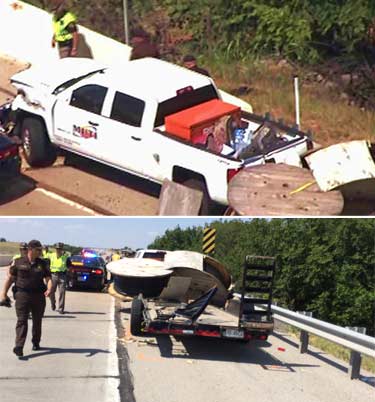 While on the trailer, one of the men saw a vehicle approaching from behind. He attempted to warn the other men while jumping clear of the trailer. Ogelsby and Flum were unable to move and were both killed after being struck by the oncoming vehicle. While on the trailer, one of the men saw a vehicle approaching from behind. He attempted to warn the other men while jumping clear of the trailer. Ogelsby and Flum were unable to move and were both killed after being struck by the oncoming vehicle.
Ogelsby had entered the profession in the past few months. Flum had a number of years of experience. Kisting said that his entire organization was deeply saddened by the men’s passing.
Ogelsby is survived by his parents, Gerry and Lisa Newsome; biological father, Spencer Oglesby; daughter, Dixie Lee; two sisters, Autumn Solt and Brooke Newsome Abney; grandparents, Carolyn and Wayne Dempsey, Verlin and Kay Newsome Annette Newsome; and other family members.
A memorial gathering will be held from 5:00 to 8:00 p.m. on Mon., September 1, 2014 at Hephzibah Funeral Home, 2546 GA Hwy 88, Hephzibah, Ga. Cards can be sent to Gary and Lisa Newsome, 1158 Piney Grove Rd., Augusta, GA. 30906.
Flum is survived by his wife, Amanda. He is father to 11-year-old Landon Francis Joseph Flum (Jessica Kegel).
He also leaves behind his parents, Bud (Dorman) and Cheryl Laycox and many other relatives and friends.
Visitation will be held Tues., September 2, 2014 from 3:00 to 8:00 p.m. and Wed., September 3, 2014 from 10:00 a.m. until the time of service at 12 p.m. at Edward Swanson and Son Funeral Home, 30351 Dequindre, Madison Heights, Mich.
In lieu of flowers, donations can be made toward his aunt Sarah and her Saving Sarah Fund. Cards can be sent to Bud and Cheryl Laycox, 7390 Silver Lake Rd., Wolverine, MI 49799.
|
With a double standard for a tower climber and reporter…
Journalist’s beheading kindles sad memories of a tower tech’s horrific death
By Craig Lekutis
August 28, 2014 – Terrorist organization ISIS released a video last week of the beheading of U.S. freelance journalist James Foley. For many, it was an unnerving reminder of the horrific 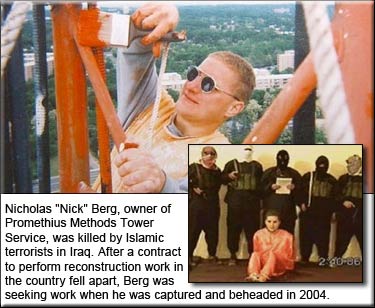 decapitation of Promethius Methods Tower Service’s owner, 26-year-old Nicholas “Nick” Berg, by Islamic militants in Iraq ten years earlier. It also presented an uncomfortable media double standard. decapitation of Promethius Methods Tower Service’s owner, 26-year-old Nicholas “Nick” Berg, by Islamic militants in Iraq ten years earlier. It also presented an uncomfortable media double standard.
Berg, of West Chester, Pa., attended four universities and while at the University of Oklahoma he invented a modular concrete block for use in tower construction, and set up Promethius Tower Services, Inc. in Kenya where steel structures were cost prohibitive.
The industrious contractor saw an opportunity to secure work for his company in Iraq and traveled to Mosul on March 14, 2004. But Berg discovered, as many tower companies have found over the years, some promised overseas projects, even secured by a legal agreement, are steeped in corrupt payment and graft terms, shady owners, and they never materialize.
While seeking other reconstruction work in Iraq, Berg, according to U.S. officials, was held for almost two weeks by Iraqi forces, but an email received by the Berg family from a U.S. consular official said, “I have confirmed that your son, Nick, is being detained by the U.S. military in Mosul.”
Please see: Released, Captured and Decapitated
|
With $45,000 fine, OSHA cites FWT after two workers are injured in Ohio
August 25, 2014 - FWT LLC has been cited for one repeat and one serious safety violation by the U.S. Department of Labor's Occupational Safety and Health 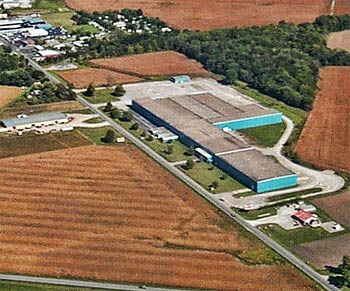 Administration after two employees were injured in separate incidents at the company's Hicksville, Ohio facility, which manufactures telecommunication towers. Administration after two employees were injured in separate incidents at the company's Hicksville, Ohio facility, which manufactures telecommunication towers.
OSHA has proposed penalties of $45,500 for exposing the workers to amputation hazards.
The Fort Worth, Tex.-based manufacturer opened the Hicksville 319,000-square-foot manufacturing plant two years ago on its 92-acre site. FWT began operations in 1959.
The injured employees were at the facility and operated cranes that loaded telecommunication poles into squaring presses, which flatten part of the poles, when the injuries occurred. On Feb. 25, 2014, an employee's hands were crushed by machinery, which resulted in lost work time. On March 17, a second employee was pinned between a telecommunication pole and the frame of the squaring press.
"The workers' injuries were serious and preventable had basic machine guards been provided on the equipment they were expected to use daily," said Kim Nelson, OSHA's area director in Toledo in a statement. "Lack of machine guarding is among the most frequently cited OSHA violations. FWT has a responsibility to protect its employees from known dangers in its facilities."
FWT was issued a repeat violation for failing to provide adequate protection on the squaring press, which exposed workers to amputation hazards. The company was cited for a similar violation at the Hicksville facility in 2013. OSHA issues repeat violations if an employer previously was cited for the same or a similar violation of any standard, regulation, rule or order at any other facility in federal enforcement states within the last five years.
One serious violation was issued for lack of guarding on the squaring press point of operation. The squaring press flattens the knuckles on the end of telecommunication tower poles, and without proper guarding, it can cause catastrophic injury. A serious violation occurs when there is substantial probability that death or serious physical harm could result from a hazard about which the employer knew or should have known.
FWT has headquarters in Fort Worth, Tex. and employs about 750 workers corporate-wide. There are 170 workers at the Hicksville facility. The company has 15 business days from receipt of its citations to comply, request an informal conference with OSHA's area director in Toledo, or contest the findings before the independent Occupational Safety and Health Review Commission.
|
Safety task force releases second PSA to get the 100% tie-off message across to every climber
August 14, 2014 - The Wireless Industry Safety Task Force today released the second in a series of public service announcements (PSA) as part of the 100% Tie-Off 24/7 Awareness Campaign. The PSA entitled “100% Tie-Off…It’s the Law” was 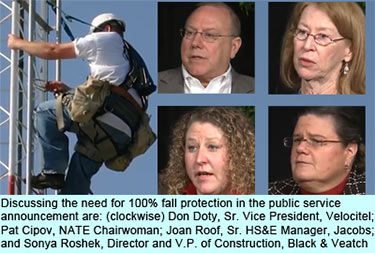 unveiled prior to the Task Force meeting that is being held in Denver, Colorado in conjunction with the 2014 National Association of Tower Erectors (NATE) Summer Conference. unveiled prior to the Task Force meeting that is being held in Denver, Colorado in conjunction with the 2014 National Association of Tower Erectors (NATE) Summer Conference.
“The Wireless Industry Safety Task Force continues to work hard to educate the industry’s workforce and stakeholders on the standards and compliance directives that govern fall protection when working on communication tower structures,” stated NATE Chairwoman Pat Cipov from Cipov Enterprises, Inc. in Sumter, South Carolina. “The fact of the matter remains, 100% Tie-Off is the Law and this PSA continues to echo that safety message,” Cipov said.
The Task Force’s 100% Tie-Off 24/7 Awareness Campaign was launched in February 2014 and continues to utilize a comprehensive grassroots approach that includes public service announcement videos, paid advertising, earned media efforts, a social media component and collaborating with State Wireless Associations in order to expand the campaign’s reach.
“This latest PSA showcases the resolute commitment that the participating companies involved with the Wireless Industry Safety Task Force have in highlighting the 100% Tie-Off law and ultimately solving all of the industry’s fall protection challenges,” said Task Force member Brad Olson from Nexius.
Click here to view the “100% Tie-Off...It’s the Law” PSA. Members of the Task Force are encouraging that everyone involved in the wireless industry play a role in helping the video go “viral” by sharing the PSA with their respective colleagues, friends and social media communities.
Participating companies and organizations affirming their commitment to the 100% Tie-Off 24/7 Awareness Campaign include: Alcatel-Lucent, American Tower, AT&T, Bechtel, Black & Veatch, Crown Castle, Ericsson, General Dynamics, Goodman Networks, Jacobs, MasTec Network Solutions, Motorola Solutions, National Association of Tower Erectors, Nexius, Nokia Solutions and Networks, SAI Communications, Samsung, SBA Communications Inc., Sprint, T-Mobile, U.S. Cellular, Velocitel, Verizon Wireless and WesTower Communications.
|
Two techs injured after their man lift drops them 30 feet in Kingston, Massachusetts
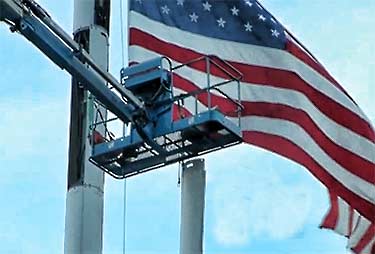 August 14, 2014 – Two tower technicians working on a flagpole cell site in Kingston, Mass. were injured Monday evening when their man lift dropped them 30 feet, but only suffered minor injuries, according to Kingston Fire Captain Adam Hatch. Having their harnesses attached to the cage most likely saved their lives. August 14, 2014 – Two tower technicians working on a flagpole cell site in Kingston, Mass. were injured Monday evening when their man lift dropped them 30 feet, but only suffered minor injuries, according to Kingston Fire Captain Adam Hatch. Having their harnesses attached to the cage most likely saved their lives.
At about 5:00 p.m. while working on the 135-foot concealed site, the two employees of Timberline Construction suddenly fell when the man lift’s hydraulics malfunctioned, causing the injuries. Witnesses said the men remained inside the cage, and their safety equipment kept them from falling from the lift.
Young football players and their families on an adjacent field saw the incident occur and called 911.
A ladder truck brought the men down to a waiting ambulance.
|
Tower painter succumbs in Illinois after an 80-to-90-foot fall from a guyed tower
UPDATE: August 12, 2014 – The Joe Daviess County Sheriff’s Office released their initial accident report today indicating that 49-year-old Thomas W. Lucas of Toledo, Ill. was at approximately the 80-to-90-foot height of a tower he was painting 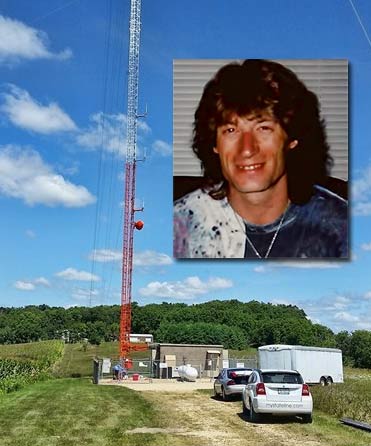 at 13668 E. Morsevillle Rd., near rural Stockton, when he fell and died from his injuries. at 13668 E. Morsevillle Rd., near rural Stockton, when he fell and died from his injuries.
Lucas was a member of a crew employed by Sherwood Tower Services of Terre Haute, Ind.
The guyed tower, constructed in 1997, is owned by Midwest Tower Leasing, Inc. of Kankakee, Ill.
Sherwood Tower Services, established in 1986, specializes in tower painting. According to OSHA’s database, the company has not received any citations since it has been in business.
Funeral services will be at noon Sat., August 16 at the Jewett Community Church in Jewett, Ill. Visitation will be held from 10 a.m. to noon Saturday at the church. Burial will be at a later date.
Lucas was born September 15, 1964 in McKees Rock, Pa. Surviving are his mother, Jackie Hoyt of Jewett; sons, Braxton Lucas of Vandalia and Ethan Lucas of Casey; daughter, Kylee Lucas of Casey and brother, Wayne Lowe of Casey.
- - - - - - - - - - - - - - - - - -
Update: August 12, 2014 - Jo Daviess County Coroner Bill Laity said that the man who fell from a communications tower in rural Stockon Sunday was Thomas W. Lucas, 49, of Toledo, Ill. According to Laity, Lucas was painting the structure when he fell. Laity did not know if Lucas was self-employed.
- - - - - - - - - - - -
August 11, 2014 – According to Stockton, Ill. Fire Chief Randy Basinger, a person fell off a radio tower and died on Sunday afternoon.
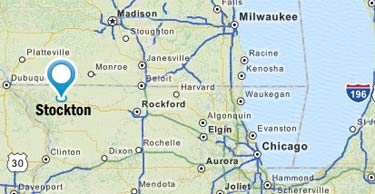 The Jo Daviess County Sheriff's Department said Sunday afternoon that more details would be released later, but as of 9:00 p.m. this evening, a spokesperson for the department informed Wireless Estimator that additional information regarding the fatality would not be available until tomorrow. The Jo Daviess County Sheriff's Department said Sunday afternoon that more details would be released later, but as of 9:00 p.m. this evening, a spokesperson for the department informed Wireless Estimator that additional information regarding the fatality would not be available until tomorrow.
According to a report overheard on an emergency services scanner, a helicopter had been requested, but was canceled after the man, who was reportedly wearing a safety harness, was pronounced dead.
Wireless Estimator will provide further details when they become available.
If the man was an industry technician, his death would represent the ninth fatality in 2014.
|
The FCC and OSHA join forces to explore the industry's high fatality and injury rates
Update: August 5, 2014 - Jonathan Adelstein, President & CEO of PCIA - The 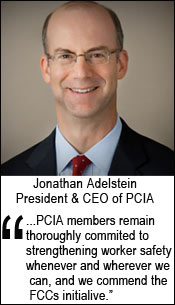 Wireless Infrastructure Association, and a former commissioner of the Federal Communications Commission for seven years, issued the following statement in response to Wireless Infrastructure Association, and a former commissioner of the Federal Communications Commission for seven years, issued the following statement in response to  OSHA and the FCC's announcement regarding its Tower Climber Safety and Injury Prevention Workshop, which will be held in October. OSHA and the FCC's announcement regarding its Tower Climber Safety and Injury Prevention Workshop, which will be held in October.
"PCIA shares the FCC’s abiding concern for worker safety and will continue to press our efforts to strengthen safety education and training at every turn. The FCC’s October workshop augments the ongoing work that PCIA has been doing with the Department of Labor, the Department of Veterans Affairs, Warriors4Wireless, and a private-public coalition to bring job training and safety skills to America’s veterans and other worker-trainees. In the coming weeks, PCIA will be working in concert with the FCC to ensure that its workshop benefits from 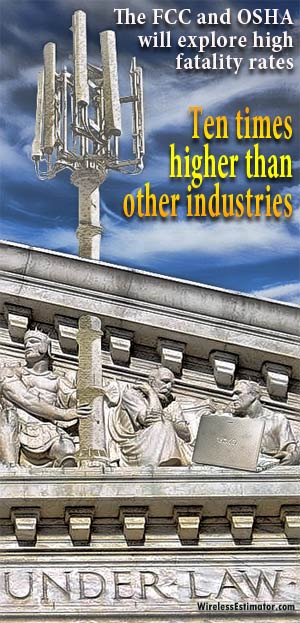 the leading safety experts in the wireless infrastructure industry. PCIA members remain thoroughly committed to strengthening worker safety whenever and wherever we can, and we commend the FCC’s initiative." the leading safety experts in the wireless infrastructure industry. PCIA members remain thoroughly committed to strengthening worker safety whenever and wherever we can, and we commend the FCC’s initiative."
- - - - - - - - - - - -
August 5, 2014 – In a joint announcement, the Federal Communications Commission (FCC) and the Department of Labor’s Occupational Safety and Health Administration (OSHA) said they will be holding a workshop on Oct. 14, 2014 to explore why the wireless infrastructure industry’s elevated workers have a fatality rate 10 times higher than that of the construction industry.
According to their public notice issued yesterday, the federal agencies’ joint task force will include panel discussions focusing on factors contributing to the high rate of tower climber injuries and fatalities, and best practices that ensure tower climber safety and prevent injuries and fatalities.
FCC Chairman Thomas Wheeler is scheduled to make remarks at the meeting to be held from 9:00 a.m. to 12:20 p.m. at the FCC Headquarters’ Commission Meeting Room, 445 12th St. S.W., Washington, D.C.
Concerned about the high fatality rate, the FCC’s Wireless Telecommunications Bureau started contacting stakeholders a number of months ago to identify if it could use its educational and enforcement capabilities to help reduce industry deaths.
The FCC has regulatory control over tower owners, however; climber safety is not a strong focus of the agency, although the need to protect them from high RF exposure has always been a high priority.
It is not known if as a result of the fact-finding conference whether the FCC will consider other worker safety initiatives that tower owners would have to comply with.
A future notice will provide further details about the participants and specific issues to be discussed during this workshop.
The FCC and the DOL will attempt to accommodate as many attendees as possible; however, admittance will be limited to seating availability. Audio and/or video coverage of the meeting will be provided over the Internet from the FCC’s Web page at http://www.fcc.gov/live.
The FCC will vote on an update of its antenna structure rules this Friday, Aug. 8, 2014.
The Part 17 Antenna Structure Report and Order would “streamline and update the rules governing the construction, marking, and lighting of antenna structures.”
The commission said the updates would “improve efficiency, reduce regulatory burdens, and enhance compliance with tower painting and lighting requirements, while continuing to ensure the safety of pilots and aircraft passengers nationwide.”
|
Some see OSHA's $14,000 fine as a slap on the wrist following the death of two techs
August 1, 2014 – When it became known earlier this year that two tower technicians were killed in West Virginia because their company did not instruct them on how to properly change out bracing during a tower modification project, it was expected by 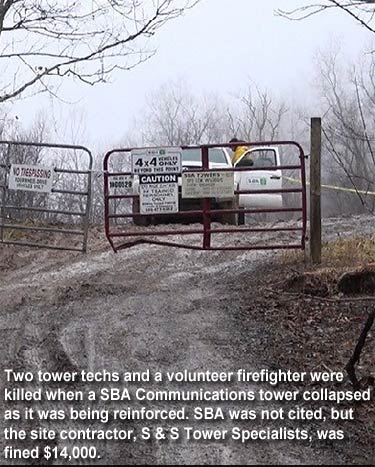 many that OSHA would cite the company with some of the largest fines issued to date – especially since the accident also killed a volunteer firefighter, and the deceased’s employer had previously been cited after an employee fell from a tower in 2009 and died. many that OSHA would cite the company with some of the largest fines issued to date – especially since the accident also killed a volunteer firefighter, and the deceased’s employer had previously been cited after an employee fell from a tower in 2009 and died.
But two citations totaling only $14,000 caught many in the industry by surprise, especially since OSHA Administrator Dr. David Michaels has been an outspoken critic of the industry’s high fatality rate and has called upon his area directors to issue willful citations wherever possible, and to also review “the tower owner, carrier and other responsible parties in the contracting chain.”
S & S Communications Specialists, Inc. of Hulbert, Okla. was issued two serious citations on July 23, 2014, and assessed a $7,000 penalty for each of the violations, which is the maximum amount allowed by law for a serious violation.
Their two employees killed were Kyle Dean Kirkpatrick, 32, and Terry Lee Richard Jr., 27.
The S & S Specialists’ crew had been reinforcing a SBA Communications Corporation tower in Clarksburg, W. Va. when the structure collapsed.
The Boca Raton-based tower company would not comment upon the accident, but emphasized in a statement issued Friday evening that they were not cited by OSHA.
“We are still deeply saddened by this event, so please join us in keeping the deceased, injured and their families in your thoughts and prayers. At this time SBA Communications will not be commenting on the details of the Clarksburg, West Virginia tower incident that occurred in February of this year. However, the Occupational Safety and Health Administration has completed their investigation and SBA has not been cited in regard to the tragic incident.”
In one citation, OSHA said, “On February 1, 2014, employees were performing modification and upgrade work on a communication tower. The employer directed employees to remove and disconnect diagonal structural members without using any temporary braces or supports. In this case, the tower collapsed and as a result of the collapse, two employees were killed and two employees were seriously injured.”
If S & S Specialists does not contest the violation, they are required to provide OSHA with an abatement plan which, according to the citation would be to “Establish and implement a written rigging plan following guidelines established in ANSI/TIA-1019-A 2012 Standard for Installation, Alteration and Maintenance of Antenna Supporting Structures and Antennas, including but not limited to (a) identify an onsite Competent Rigger to identify hazards and authorize corrective measures (Section 2.2.1), (b) involving a Qualified Engineer to perform an analysis of structures and components (Sections 2.2.1), (c) the use of temporary members capable of supporting the loading condition when removing a structural members (Section 2.7.1), and (d) identifying the critical steps in the process to be followed by the rigging crew (Section 2.7).”
The tower erector’s second citation was because “the employees tied off to the diagonal and horizontal bracing which was not capable of supporting at least 5,000 pounds.”
The citation read, “Anchorage used for attachment for personal fall arrest equipment was not capable of supporting at least 5,000 pounds (22.2kN) per employee attached nor was it designed, installed and used as part of a complete personal fall arrest system which maintains a safety factor of at least two, and under the supervision of a qualified person.”
“I don’t see why they weren’t issued a willful citation,” said a safety director of one of the nation’s largest contractors who requested anonymity after he reviewed the citations obtained by Wireless Estimator. “In addition to not providing their employees with an engineered plan to change out those braces safely, S & S was also charged with not providing their employees with a fall protection system plan. To me that’s a willful disregard for their employees’ welfare and they should have been given at least a $70,000 fine for each of the violations.”
Four other industry managers contacted by Wireless Estimator also registered their concern about the $14,000 in fines being too lenient.
“That’s absurd. A company recently got hit with over $50,000 in fines for a couple of guys free climbing. There was no accident, just free climbing. S & S might even ask for a hearing or contest it and it might be less than the piddling amount of money they were fined,” said one manager.
"These deaths are a painful reminder of the dangers associated with communication towers, and are at the root of OSHA's directive on communication tower construction activities," said Prentice Cline, OSHA area director for Charleston. "OSHA is concerned about the alarming increase in preventable injuries and fatalities at communication tower work sites. The agency is collaborating with the National Association of Tower Erectors and other industry stakeholders to ensure that every communication tower employer understands how to protect workers performing this high-hazard work."
|
AT&T's additional remote radio heads put some structures over capacity
July 29, 2014 - An increase in weight and wind loading caused by additional remote radio heads appears to be a primary contributor to AT&T's decision to reassess their cell site of the future and put many new cell sites on hold throughout the nation.
According to two AT&T construction managers the new loading was in some cases tripling the anticipated build cost due to expensive retrofitting expenditures that would be required.
.jpg)
Although a recent news article quoted a contractor stating that "the radio heads AT&T initially wanted to put on top of its towers weighed as much as 500 pounds," it's unlikely that an RRH could conceivably weigh that much, according to an AT&T project manager at a major turfing vendor, who said, "The effectiveness of a base station isn't based upon its weight,"
New site builds came to a screeching halt last May as the carrier assessed its program to integrate its 700 MHz, 850 MHz, 1.9 GHz and 2.3 GHz spectrum bands. According to one AT&T cell site of the future construction drawing reviewed by Wireless Estimator, each sector would have six RRHs with two antennas and a junction box, requiring the mounting frame to support approximately 1,500 lbs. of equipment, close to twice the weight of an AT&T LTE site.
The Alcatel-Lucent RRHs average 40 pounds each and the antennas weigh in at 68 pounds.
AT&T's network equipment and engineering varies throughout the nation based upon topography and other factors.
| Per Sector |
|
Lbs. |
Lbs. |
| 2 |
ALU 2x40-700 (LTE) |
52.1 |
104.2 |
| 2 |
ALU 2x40 AWS (LTE) |
44.0 |
88.0 |
| 1 |
ALU 2x60 850 (UMTS) |
50.2 |
50.2 |
| 1 |
ALU 2x60 1900 UMTS) |
43.0 |
43.0 |
| 1 |
FIBER DISTRIBUTION BOX |
20.3 |
20.3 |
| 2 |
92.4” x 14.8” ANTENNA |
68.0 |
136.0 |
| 6 |
RRH MOUNTING HARDWARE |
10.0 |
60.0 |
| |
TOTAL POUNDS |
|
501.7 |
Many structures throughout the country are at near capacity and reanalyzing them under TIA 222-G with even the slightest of additional loads can result in the need to retrofit or replace them.
Although some work is starting to be released by AT&T such as site surveys, many contractors are still slow as AT&T reassesses it's network program.
On July 23, AT&T reported their earnings and stated that their capital spending plan for the full year had not changed.
|
If you are in compliance...
Riding the line is now legal anytime when techs
are working on a tower
Update: July 24, 2014 – The release of OSHA's new communications tower directive allowing workers to be  hoisted to their work station at any time - which was stalled for over 12 years – appears to have been driven by the industry suffering 14 hoisted to their work station at any time - which was stalled for over 12 years – appears to have been driven by the industry suffering 14 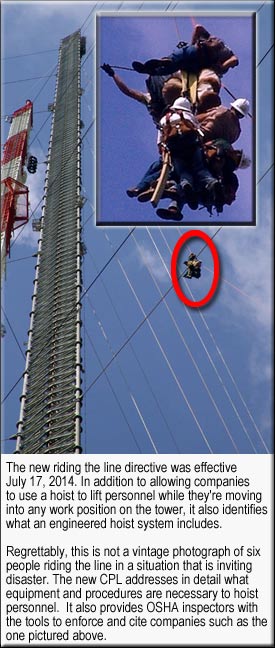 deaths in 2013 and eight fatalities this year, according to a press release issued by OSHA this afternoon. deaths in 2013 and eight fatalities this year, according to a press release issued by OSHA this afternoon.
The statement said that the release of the new directive is the latest in a series of actions OSHA has taken to improve cell tower safety. It also said, “This follows an alarming increase in preventable injuries and fatalities at communication tower work sites."
“This directive ensures that communication tower workers are protected regardless of the type of the work they are doing on communication towers,” said Dr. David Michaels, assistant secretary of labor for occupational safety and health. “Employers and cell tower owners and operators must make sure workers are properly trained and protected.”
- - - - - - - - -
July 23, 2014 – After dozens of meetings over a dozen years, OSHA has released a new compliance directive for hoisting personnel to or from their workstations on a tower. The previous OSHA instruction only allowed hoisting personnel during new tower construction.
The new instruction allows companies to use a hoist for raising or lowering a maximum of two employees while they’re moving into position to retrofit, maintain or perform any other required services on the structure.
However, it’s important to note that although the majority of changes were semantical, and the instructions appear to be similar, there are a number of changes that have been added, and a thorough review of the directive is required for full compliance.
The new directive, CPL 02-01-056 became effective July 17, 2014 and is available for review here.
As an example, the instruction now references five new standards and it identifies what an engineered hoist system includes. Among other additions, it has expanded training requirements and additional weather condition directives as well as precautions to avoid falling objects.
New instruction had a slow storied past
In the late 1990s the National Association of Tower Erectors had lobbied OSHA to change its inspection policy by removing the restriction on hoisting employees on the hoist line to their work stations if those work stations are lower than 200 feet.
They were partially successful. On March 26, 2002 OSHA came out with a new directive allowing the change, but it only applied to the construction of new towers.
The trade group immediately kick-started a new educational campaign to educate OSHA about repetitive injuries technicians were receiving due to the need to oftentimes climb as much as a 1,000 feet or more in a given day.
NATE’s Legislative and Regulatory Committee worked tirelessly over the years to revise the instruction, but saw their proposal languish as priorities changed with new OSHA administrations.
Late last year it had been rumored by a number of safety executives that a ranking OSHA official had said the new directive wouldn’t see the light of day.
During a keynote video presentation in March during NATE's annual convention, Assistant Secretary of Labor Dr. David Michaels said that OSHA was close to revising the industry’s riding the line standard to reflect that riding the line will be permissible while performing installations, modifications and 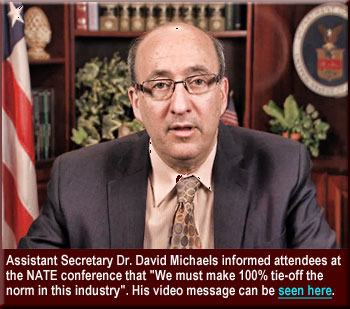 maintenance on elevated structures. maintenance on elevated structures.
NATE Executive Director Todd Schlekeway said that he hadn’t had the opportunity to review it as he was currently taking an authorized climber and authorized rescuer course in Virginia with other industry leaders who were also completing the training side-by-side with OSHA officials.
Schlekeway said that NATE would have liked to have seen it sooner, but was pleased that the directive was issued.
“From an industry workforce perspective, for those compliant companies who use personnel hoists it will certainly assist in reducing repetitive stress on climbers accessing the tower,” said Schlekeway.
Current members of the Legislative and Regulatory Committee include Kevin Hayden, Don Doty, Jim Miller, Jim Goldwater and Schlekeway.
OSHA Relations Committee members include: Chairman/Board Oversight John Paul Jones, Gordon Lyman, Pat Cipov, Jim Coleman, Kevin Dougherty, Don Doty, Sean Cooper, Loui McCurley and John Matias.
Within 60 days, State Plan states must notify OSHA of their intent to adopt the new directive or indicate that they already have similar enforcement guidance in place.
It is expected that Assistant Secretary of Labor for OSHA Dr. David Michaels will be issuing a statement regarding the new directive.
|
Texas tech rescued in Florida after suffering from heat exhaustion during microwave install
July 23, 2014 – A Texas-based tower technician was rescued from a tower in Crawfordville, Fla. yesterday afternoon after heat exhaustion began to immobilize him 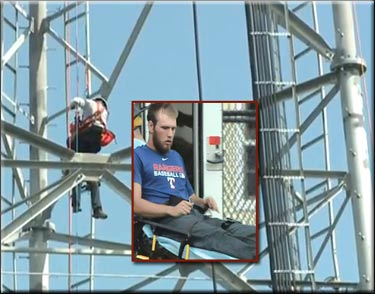 as he worked at the approximately 260-foot level on a Talquin Electric microwave tower. He was transported in good condition and great spirits to Tallahassee Memorial Hospital for medical assessment. as he worked at the approximately 260-foot level on a Talquin Electric microwave tower. He was transported in good condition and great spirits to Tallahassee Memorial Hospital for medical assessment.
According to the Tallahassee Fire Department, at around 1:30 p.m., the Wakulla County Fire Rescue was called out by a Texas contractor’s employee working on Talquin Electric’s tower located at 681 Wakulla-Arran Rd. in Wakulla County.
The rescued tech began displaying heat exhaustion symptoms while some 260 feet up the 350 foot tower and contacted his coworkers on the ground for help. His co-workers said he was asking incoherent questions.
Fire officials with Wakulla County Fire Rescue arrived on the scene along with an off duty Tallahassee Fire Department Lieutenant and called for mutual aid from TFD.
Members of TFD's Urban Search and Rescue Team arrived at around 2:30 p.m. and climbed the tower to harness the technician in with safety gear and lower him to the ground.
The temperature during the rescue was approximately 87 °F.
|
A bottle of urine helped to revamp a national contractor's drug screening program
By Richard Chapman
July 18, 2014 – Contractors unanimously agree that drug testing within our industry is not an option, but a hard-and-fast regulation. And in an industry that appeals to young  tend to men and women who have risk-taking personalities, it is inevitable that a percentage of that workforce would engage in drug use. tend to men and women who have risk-taking personalities, it is inevitable that a percentage of that workforce would engage in drug use.
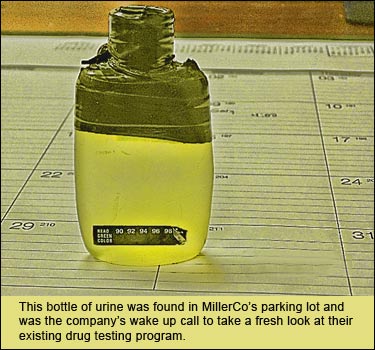 However, while virtually any contractor in business today will claim that they promote a drug-free workplace, one sometimes has to wonder if those policies are just compliance-driven, or truly sincere efforts to maintain a safe working environment. However, while virtually any contractor in business today will claim that they promote a drug-free workplace, one sometimes has to wonder if those policies are just compliance-driven, or truly sincere efforts to maintain a safe working environment.
So what does a serious substance abuse program require? At a minimum, a company should practice pre-employment screening, random screening, and for-cause screening. For-cause can be triggered by a traffic or workplace accident, or documented suspicion of impairment or documented consistent poor performance. Within our company, MillerCo, Inc., any of these will generate a drug test. In addition, a “near-miss” incident will initiate one as well.
Once you have your policies in place, what kind of drug test is best for your situation?
Urinalysis is the most common, but this test can be defeated by a determined employee. Hair follicle testing is much more difficult to defeat, but has the drawback of requiring that a sample be sent off for analysis, usually taking two to three days to get results. In addition, they are typically more expensive, although the prices have begun to fall somewhat. The answer, at least for MillerCo, Inc., has been a combination of both (continued). Please see: A bottle-based epiphany
|
Caught free-climbing with makeshift lanyards...
A dropped dime adds up to a $52,200 OSHA fine for a federal broadband project contractor
July 17, 2014 - An unknown caller concerned about a tower company’s employees free climbing on a monopole dropped a dime on a Parkersburg, W.V.-based contractor by contacting OSHA. After an OSHA investigator responded to the Coolville, Ohio site he found numerous violations, and an area director cited Morlan Enterprises, Inc. with 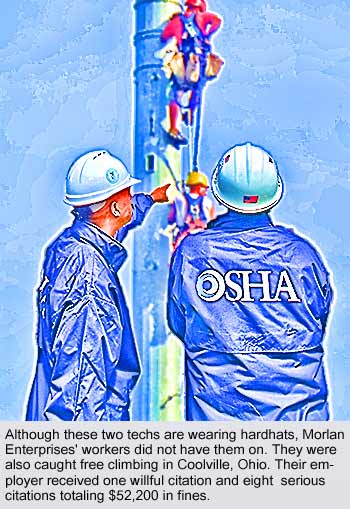 one willful violation and eight serious violations totaling $52,200 in fines. one willful violation and eight serious violations totaling $52,200 in fines.
Morlan Enterprises' crew most likely did not anticipate a visit from OSHA as they worked on the tower surrounded by trees that tucked it away in a rural community with 496 residents sheltered inside on a sub-freezing day.
However, on Feb. 25, 2014, an OSHA inspector observed two of Morlan Enterprises' tower technicians descending a 195-foot monopole located at 43078 Elk Run Rd. without being tied off. He noted that another technician from the three-man-crew was on the ground.
Upon further examination the investigator found that the company failed to ensure “workers climbing the tower were using effective and adequate fall protection, including installing a climbing cable to the tower,” and the company was fined $35,000 for a willful violation.
Although a willful violation – one that is committed with intentional, knowing or voluntary disregard for the law’s requirement or with plain indifference to employee safety and health – can be accompanied with a maximum fine of $70,000, Columbus Area Director Deborah Zubaty signed off on a 50% reduction.
OSHA’s penalty calculation system takes into account nine factors such as whether the citation was a repeat violation, the size of the company, and if the company has a citation-free history.
According to OSHA’s website’s database, Morlan Enterprises does not show any previous citations.
However, the $35,000 penalty is considerably higher than most fines given to companies for fall protection violations, especially considering the violations were not found during an investigation that involved a serious injury or fatality.
Zubaty may have been guided by Directorate of Construction’s Director James G. Maddux’s memo that “When workers are not using effective fall protection, the fall hazards are obvious, well known and potentially fatal. In appropriate cases, Area Directors should work closely with their Regional Solicitor to develop willful fall protection citations, including, when applicable, citations of the general duty clause.”
Morlan Enterprises' citation was the first industry willful citation issued since Maddux issued the memorandum on Nov. 8, 2013.
"Free climbing a communication tower is extremely dangerous, and it was this company's responsibility to ensure appropriate fall protection was provided and used," said Zubaty. "Employers and cell tower owners and operators must do everything possible to stop senseless, preventable tragedies in the communication tower industry."
Morlan Enterprises was cited with eight serious violations: failing to provide workers with training on fall hazards, provide personal protective equipment, such as shock-absorbing lanyards and hard hats; and requiring workers to purchase their own fall arrest harnesses and other protective equipment. Other violations involved failing to make provisions for prompt medical attention, such as an emergency services information document, before starting work, and having first aid kits available for emergencies.
One of the serious citations stated that one employee was wearing a full body harness with a single makeshift lanyard made from a general purpose lifting sling. The sling had a label which indicated a vertical capacity of 2,400 lbs., therefore not meeting the 5,400 pound nominal breaking strength required in 29 CFR 1926.104(d).
Another employee's makeshift lanyard had a label on the sling indicating a vertical capacity of 3,200 lbs.
Morlan Enterprises was contracted by New Era Broadband Services of Coolville to perform tower construction and antenna installation services at 20 locations in the Meigs County area. The New Era Broadband construction project is being funded by a grant, administered through the U.S. Department of Agriculture-Rural Utilities Service, to bring broadband services to underserved communities in the area.
Morlan Enterprises has 15 business days from receipt of its citations and penalties to comply, request an informal conference with OSHA's area director, or contest the findings before the independent Occupational Safety and Health Review Commission. The citations were dated July 7, 2014.
Founded in 1999, Morlan Enterprises’ president is Larry Morlan, according to a corporate filing with West Virginia
|
Friday night lights are minus one as mod crew sets cell tower ablaze in Ohio
July 15, 2014 – A subcontracted crew that was retrofitting a combination cell tower and stadium lighting pole reported to authorities this 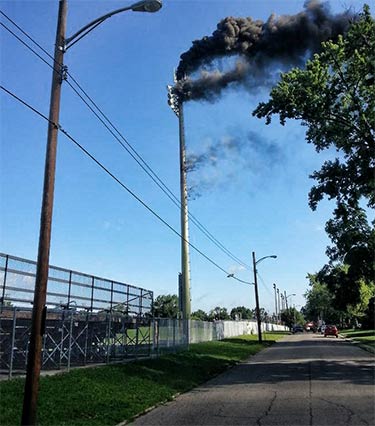 morning at around 9:30 a.m. that the structure was on fire. morning at around 9:30 a.m. that the structure was on fire.
Fire department personnel responded to the Grandview Heights, Ohio High School football field and extinguished the fire that was reportedly started when the structure’s transmission lines caught fire while a crew was welding at the base of the monopole.
Authorities did not release the name of the contractor that was working on the Sprint site being managed by General Dynamics. The fire department stated that the structure wasn’t going to collapse and nearby residents were allowed to return to their home.
Representatives from Sprint were on site to assess whether the structure would be required to be taken down and replaced.
|
Rigging accident severs off a technician's head and arm in Cynthiana, Kentucky
Update: July 3, 2014 – Authorities have identified the tower technician who died yesterday in Cynthiana, Ky. as 28-year-old Joel Metz of Indiana. He was employed by Indianapolis-based Fortune Wireless, Inc.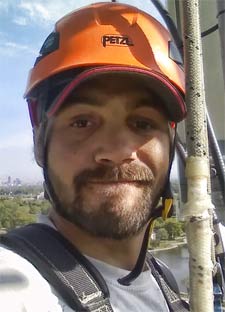
On Tuesday, stating, "Nice huh", Metz posted a photo on his Facebook page of a panoramic Kentucky landscape, taken from high atop the tower close to where rescue workers retrieved his body yesterday at around 10 p.m. after a rigging accident took his life eight hours earlier.
Metz doted upon his three sons, ages five, seven and eight.
Yesterday, Verizon Wireless, who owns the tower and contracted with Fortune Wireless to install new sector mounts, said in a statement: "Our thoughts are with the family and colleagues of those impacted by today's incident near Cynthiana, Kentucky. We are working closely with our vendor and first responders on the scene as we continue to gather additional information."
Representative of Fortune Wireless and OSHA were at the tower site this morning.
Wireless Estimator will provide the service arrangements for Metz when they become available.
- - - - - - - - - - -
July 2, 2014 - A tower technician was dismembered and decapitated this afternoon while working on a Verizon tower in Cynthiana, Ky. when rigging failed and a rope 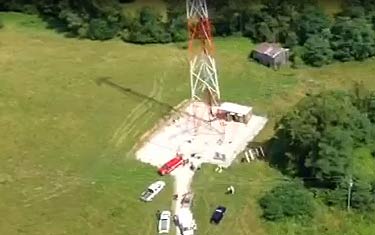 wrapped around his neck and arm, according to Harrison County Sheriff Bruce Hampton who said the man was part of a four-member crew from Indiana. wrapped around his neck and arm, according to Harrison County Sheriff Bruce Hampton who said the man was part of a four-member crew from Indiana.
Sheriff Hampton said the men were taking down an old boom and bringing up a new one when a cable broke at about 2:20 p.m., killing the man who was in his 20s.
The deceased worker was tied off when the accident occurred and remained hanging at approximately the 240-foot level for almost six hours until a crew from Northern Kentucky Technical Rescue from Erlanger was able to begin taking the worker down.
An official from Verizon had contacted NKTRT to assist in recovering the technician who was on the tower with another worker who was not injured. Two men were on the ground when the accident occurred at the Waits Rd. tower site.
The sheriff said that all of the crew members are in their 20s.
The technician was the eighth worker to die this year while working on an elevated structure. In 2013, fatalities spiked to 14 after a record-safe year in 2012 that only had one death.
Wireless Estimator will provide updates regarding this horrific tragedy as they become available.
|
Sometimes you just have to get graphic to get the 100% tie-off message across
July 1, 2014 - The Wireless Industry Safety Task Force’s 100% Tie-Off 24/7 awareness campaign is driving home the message that there should be a zero-tolerance policy regarding this law. Although every tower technician knows that they should be tied off at all times, the majority of fatalities and serious injuries have resulted because they weren’t. The message isn’t new, but the way it’s being presented is. should be tied off at all times, the majority of fatalities and serious injuries have resulted because they weren’t. The message isn’t new, but the way it’s being presented is.
This time almost two dozen of the infrastructure industry’s largest companies, from Alcatel-Lucent to WesTower Communications, have joined forces to promote the law requiring 100% tie-off. Their excellent public service announcements are getting media play, but it’s the commitment of the nation’s 1000-plus companies who employ technicians who work on elevated wireless structures that will make it successful.
As part of Orlando-Fla.-based Atlantic Tower Services’ commitment to safety, the company is requesting that all of their employees sign a tie-off certificate and they’ll be provided with a challenge coin that they’ll carry with them.
According to ATS Industrial Safety Manager Scott Clements, the company’s technicians are being asked to carry it at all times in order to show their acceptance of safety, quality and commitment in the work that they do.
“Let it serve as a reminder of those attributes and your commitment to 100% tie-off 24/7 each and every time you reach into your pocket,” said Clements.
Get graphic to get the message across
To assist in promoting the task force’s campaign, Wireless Estimator is providing a 100% tie-off graphic that can be used for certificates, posters, t-shirts, trade show giveaways, vehicle signs, web sites or any other unique item that will assist in promoting the tie-off safety message.
The large 2665 X 3713 file (300 Resolution - 7MG .png) is available here. If you would like to slightly customize the graphic or need a different size or format, send us an email and we’ll see if we can assist at no charge. Our reward is in knowing that your efforts will result in a marked improvement in reducing fatalities and injuries.
Also, send us a photograph and details as to how you’ve creatively used the graphic and we’ll be pleased to review it for publication.
|
Risky behavior might have contributed to a tower tech's 80-foot fall in Connecticut
June 27, 2014 - A technician fell approximately 80 feet from a Crown Castle International cell phone tower on Ingaham Rd. in Old Saybrook, Ct. on May 31, 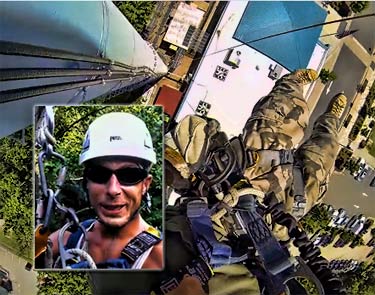 2014, and fortunately his only injury was a broken femur. Unfortunately, his YouTube selfies signaled that it was bound to happen and risky behavior might have contributed to the accident. 2014, and fortunately his only injury was a broken femur. Unfortunately, his YouTube selfies signaled that it was bound to happen and risky behavior might have contributed to the accident.
Anthony Oross, an employee of PCRG of Inman, S.C., was performing a regularly scheduled asset inspection on a Crown Castle monopole when he fell. A Crown Castle spokesperson said that they were aware of the incident and that the man was qualified to be on their site having recently been re-certified as a competent climber.
But what Crown Castle and most likely PCRG did not know was that Oross appeared to be an adrenaline junkie fixated on violating safety practices while at work, as seen in YouTube videos he posted over the years.
In a 2013 video with 118 views, Oross is seen rappelling down from a monopole without being tied off as he swings his legs while humming as if he didn’t have a care in the world. When he gets to the bottom he detaches his Fisk Descender and as he walks towards another crew member – who may or may not have seen him rappel – he comments in reference to the descender, “Oh, she’s a bit warm”.
“There are three issues that jump out at me on this video,” said Todd Horning, Director of Training for Safety One International.
“First is the fact that he is using the Fisk, a device that can be deadly if not used 100% correctly. People often make mistakes. Second, he is using a single rope system. Every standard says that techs should use a two rope system unless it is a true emergency and this clearly isn't. Third, he seems to generally disregard safety, and gives the impression that working at heights should not be taken seriously. It definitely shows complacency for the hazards, in my opinion," said Horning.
In another video from two years ago with 94 views, Oross is only attached to a Fisk on a single rope as he spins around multiple times laughing as if he was a child in a tire swing.
As the 28-second video closes, Oross says, “God, I love this f*#@ing job”.
Connecticut OSHA area director Robert Kowalski said that his office is reviewing the accident and he could not comment upon it until such time as the investigation is closed.
Oftentimes OSHA will site a company for employer negligence when there is a serious accident or fatality, but many times an administrative law judge will reject the citation if the company can prove that the accident occurred through employee misconduct.
Initial findings on a recent fatality indicate that the decedent might have purposely cut one of the lanyards on his Y-lanyard since it proved to be more convenient when climbing.
Although that would appear to be employee misconduct, OSHA could site the employer if proper training or requisite inspections were not performed which would have prevented the technician from using faulty personal protective equipment
|
AT&T's hurry up and wait model results in layoffs at WesTower and Velocitel
June 26, 2014 – Wireless network service providers WesTower Communications and Velocitel have terminated employees as AT&T’s spending freeze continues to cut into revenues of companies committed to the 4G build-out plan which came to a grinding halt as first reported by Wireless Estimator on May 22, 2014.
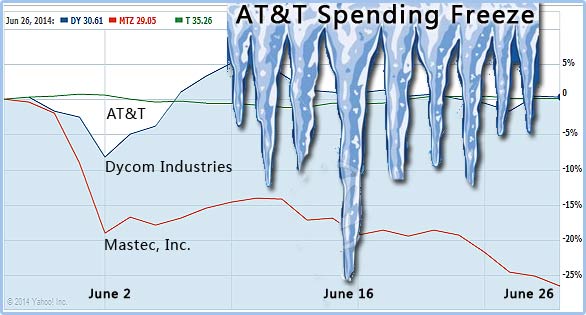 The two turf vendors join MasTec Network Solutions, a Florida-based turfing vendor that began laying off workers earlier this month as their crews and project development personnel remained idle. A number of employees of the two companies who were let go this week contacted Wireless Estimator, but they did not know how many workers their companies were cutting. The two turf vendors join MasTec Network Solutions, a Florida-based turfing vendor that began laying off workers earlier this month as their crews and project development personnel remained idle. A number of employees of the two companies who were let go this week contacted Wireless Estimator, but they did not know how many workers their companies were cutting.
It is expected that if AT&T’s Q3 and Q4 capex cuts continue that Goodman Networks, Bechtel Telecommunications and Black and Veatch will also be faced with having to downsize.
Palm Beach Gardens, Fla.-based Dycom Industries, Inc.’s revenues should also be impacted since the firm provides a considerable amount of services to AT&T through many of its operating subsidiaries such as Ansco & Associates, NeoCom Solutions, Inc. and Spectrum Wireless Solutions.
However, if AT&T is successful in its bid for DirecTV, Dycom could benefit from AT&T’s promise to expand its broadband offering to 15 million customers, positioning Dycom to be a key player with its 45 subsidiary companies.
When analysts learned about AT&T’s spending deferrals in late May, Dycom’s stock nosedived along with MasTec, but recovered its losses by within a week.
MasTec continued to drop and is down 27% after their announcement that the AT&T slowdown will result in weak earnings for the second quarter. CEO José Ramón Mas told analysts that he viewed the fall as a buying opportunity. AT&T had a slight drop after the DirecTV announcement, but its stock has remained at around $35 per share.
The industry will be awaiting AT&T’s earnings report expected on July 23, 2014 to see if it will provide any guidance on the carrier’s 4G build-out plans.
Numerous terminated workers have said that they have had many employment offers after posting their resume on Wireless Estimator.
|
As AT&T's deferrals cripple a number of businesses...
Sprint's T-Mobile deal will have few folks standing up for wireless contractors
Commentary
June 20, 2014 – If the rumored deal of Sprint Corp. buying T-Mobile USA becomes a reality, it could sound the death knell for many contractors and their workers, and cut heavily into suppliers’ margins. Although trade organizations and vertical realtors will privately agree that it’s detrimental, there will be a deafening 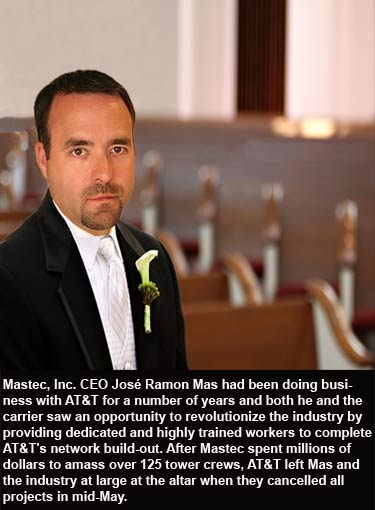 silence on their part. silence on their part.
If the acquisition moves forward this summer you can expect media coverage to be 10% news and 90% cut and paste pablum, most of it extolling the merits of innovation and competition in wireless services by three strong fully capitalized companies rather than AT&T and Verizon’s duopoly stifling two weak sisters..
Don’t bite the hand that feeds you lease amendments
It’s reasonable to anticipate that the nation’s tower asset companies will stay out of the fray, but tacitly support it with mixed messages.
The pressure that will be placed upon them to back the merger comes straight from their annual reports.
Crown Castle International’s consolidated site rental revenues for Sprint and T-Mobile represent a whopping 45%. Since both carriers currently reside on about 8,000 of their sites the possible loss of T-Mobile’s site rental revenues would be a healthy 10% drop, but they’re not about to question Sprint’s acquisition.
Crown Castle CEO W. Ben Moreland said at a roundtable presentation at the PCIA show last month in Orlando that his company was poised for continued success, partially because of expected T-Mobile collocation activity later this year.
American Tower Corporation said that Sprint and T-Mobile combined accounted for 26% of their operating revenues, and both carriers share approximately 5,500 sites.
In financial reports, SBA Communications continues to state that T-Mobile’s modernization initiatives and lease amendments have had a marked impact upon the company’s earnings.
In 2011, when AT&T began its failed attempt to buy T-Mobile, Crown Castle said that T-Mobile represented 11% of its revenues, mirroring a similar percentage of American Tower’s U.S. revenues.
It is not known if they were fending off the possibility that analysts might toy with a downgrade, or if they were strong-armed by AT&T to make a statement, but Crown Castle and American Tower provided information pertaining to how lease-ups and revenues historically rose following a merger.
That may have been accurate in 2000 when Vodafone Airtouch, Bell Atlantic and GTE morphed into Verizon, the nation’s largest carrier, but making that statement today would be disingenuous.
However, hypocrisy is a hallmark of big telecom companies with T-Mobile’s CEO, John Legere, becoming its most visible poster child.
When AT&T was courting T-Mobile, Legere was doing Hugo Boss butt bumps and high fives with Randall Stephenson, AT&T’s chief executive.
At the same time, Sprint was asking the FCC to block the merger because “Removing T-Mobile from the market would substantially reduce the likelihood of market disruption by a maverick. T-Mobile, as one of only four national carriers, provides a critical constraint on AT&T’s consumer retail prices.”
Nine months later the deal didn’t go through and AT&T had to pay Deutsche Telekom $4 billion in cash and wireless spectrum access.
Instead of sending Stephenson a thank you note and returning the engagement gift, maverick Legere hurled invectives at Stephenson and AT&T, and structured T-Mobile's "uncarrier" approach to contract-free wireless networks, a methodology that has added millions of new customers to its network over the last year.
So, scratch innovation
Supporting the merger with Sprint, Legere said in an interview Wednesday that innovation and competition would only intensify if Sprint were to acquire T-Mobile. In March, however, he said that AT&T, Verizon, and Sprint’s innovative subsidy model was “the biggest crock of sh-t I’ve ever heard in my entire life.”
Contractors and suppliers could see lean times if there is a merger once site decommissioning is accomplished. If the towercos’ fairytale wish for additional lease-ups came true, they would benefit, but installation and product pricing would be seriously constrained through less competition.
If the deal is not derailed, it is not known whether the National Association of Tower Erectors or PCIA – The Wireless Infrastructure Association will argue during a comment period that the merger would have a devastating impact upon wireless workers, their companies and industry suppliers.
They didn’t register those concerns when the AT&T/T-Mobile merger was proposed.
Legere attacked AT&T and Verizon during a product rollout this week, stating, “These high and mighty duopolists that are raping you for every penny you have. The f—ers hate you.”
It would be interesting to find out how he feels about contractors. It’s well-known how AT&T views their vendors.
No good deed goes unpunished
On May 13, 2014, AT&T spent more than $140,000 on a half-page ad in the Wall Street Journal to publicly thank eight vendors and present them with their 2014 AT&T Supplier Award.
Wireless contractor MasTec Network Solutions was one of those heralded for their “commitment to collaboration.”
MasTec partnered with AT&T to roll out the Tower Crew Augmentation Program (TCAP), an initiative that cost the 85-year-old company millions of dollars to develop so that AT&T could be assured that they would be able to have the trained and experienced workforce necessary to build out their network.
The Coral Gables, Fla.-based company built a mammoth 350,000 square-foot training facility in Charlotte, N.C. and amassed over 125 tower crews dedicated to AT&T’s build-out based upon the carrier’s commitment that there would be a guaranteed stream of work through at least 2016.
They also opened up a number of offices with long-term leases to service AT&T.
AT&T throws MasTec under the bus
But during the same week that 2.4 million WSJ readers were being informed about MasTec’s commitment to excellence, AT&T put a freeze on almost all of MasTec’s work if it wasn’t already shovel ready or in progress.
AT&T provided them with no details as to when the deferred projects might resume, and MasTec’s overhead hockeysticked as their revenues plummeted, forcing them to reach out to financial analysts and provide adjusted guidance for their second quarter earnings.
Within six weeks the freeze shaved an anticipated $45-$50 million in revenues, according to CEO José Ramón Mas.
In early June he said that he would reassess the loss of the AT&T work and might have to consider “rightsizing”, a euphemism for layoffs. And those began this week, according to a number of MasTec employees who contacted Wireless Estimator.
Also, the company reportedly let go two employees that were dedicated to supporting the Warriors 4 Wireless program.
Regulators should be alerted
AT&T enticed MasTec and other large turfing vendors and contractors into bed with them with a promise of a long-term marriage, but – to traffic in Legere’s vernacular – proceeded to rape them while AT&T’s executives gang-banged an entire industry through their ineptness in designing, financing and integrating their network plans.
Fortunately, in a labor force-strapped business, many workers who were dependent upon the AT&T build-out will be able to move to other companies servicing Verizon, Sprint and T-Mobile
Hopefully, that will resonate with Washington regulators to identify that reducing the big four to three would have a severe impact upon the profitability and stability of the industry tasked with ensuring America maintains the most robust and secure communications systems in the world.
--CEL
|
Fatal fall claims the life of a 28-year-old tower technician in San Angelo, Texas
Update: June 19, 2014 - Services have been scheduled for Cody Freeman, 28, who fell from a tower to his death on Tuesday in San Angelo, Tex.
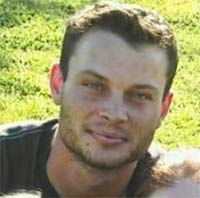
A resident of The Colony, a northern suburb of Dallas, Freeman is survived by his wife, Nyssa; children, Annabella and Gabrie; mother, Angela Garner of Van Buren, AR; brothers, Anthony Freeman and wife Sara of Pocola, OK and Aaron Fielding of Lewisville, Tex.
Funeral service will be held at 4:00 p.m., Monday, June 23, 2014 at Turrentine-Jackson-Morrow Chapel in Allen, Tex. The family will receive friends during a visitation being held Sunday evening, from 6:00 p.m. until 8:00 p.m. at the funeral home.
If you would like to assist the family during their time of need, donations can be made here.
- - - - - - - - - - -
June 17, 2014 – A tower technician fell to his death in San Angelo, Tex. this afternoon from a self-supporting tower, according to a police department press 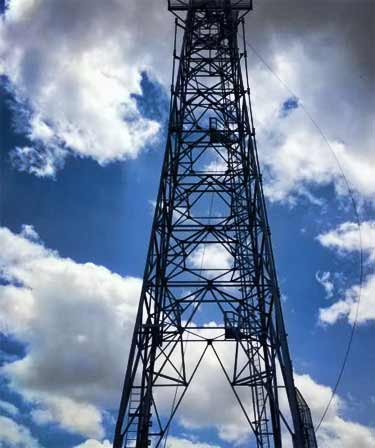 release. The report said that the man was at approximately the 140-foot level when he fell. The statement said he was employed by Microwave Transmission Systems, Inc. of Richardson. release. The report said that the man was at approximately the 140-foot level when he fell. The statement said he was employed by Microwave Transmission Systems, Inc. of Richardson.
At 1:50 p.m., San Angelo Police were dispatched to 378 S. Chadbourne St. to investigate a report of an unconscious tower worker. Upon arrival, they were met by San Angelo Fire Department personnel who stated that a man had fallen from the tower and was deceased.
Police later learned the 28-year-old victim was doing repair work on the tower when he experienced issues with his safety equipment and fell. A technician knowledgeable of the incident said that the man might have customized one of his lanyards. OSHA is investigating the fatality.
Police are not releasing the victim's name until his next of kin have been notified. The technician was married and had two children. It is not known how long he had been workiing in the industry.
"What they're doing is they're refurbishing this tower. I believe they are making adjustments to refurbish it into a cell tower," Public Information Office Tracy Gonzalez said in a press report. "Other workers that are doing some work in the area--now that they're aware of the situation--they're providing some support for the workers that were here."
The tower is a fixture in downtown San Angelo and was originally built to mount multiple large two-ton feed horns that were part of the old AT&T long distance network.
The retrofitting project, reportedly being undertaken for AT&T, was being managed by Goodman Networks.
A press release from Charlie Guyer, VP Communications, said: "The company has just been informed of a fatality involving one of our subcontractors, Microwave Transmission Systems (MTSI). We extend our deepest condolences to the family. We are conducting an investigation and are fully cooperating with local, state and federal authorities.
The structure is not registered in the FCC’s database.
The man’s death was the seventh fatality this year. In 2013, fatalities spiked to 14 after a record-safe-year in 2012 that only had one death.
|
AT&T's capital spending freeze blindsides contractors and turfers as projects are put on hold
UPDATE: June 12, 2014 – AT&T’s turfing vendors are laying off contract and permanent workers as a direct result of the carrier’s freeze on wireless builds throughout the nation, according to industry sources.
O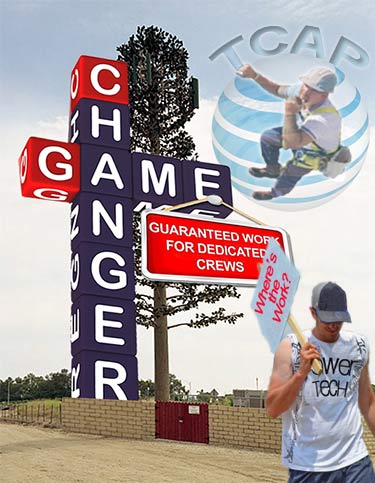 ne major integration company terminated dozens of employees earlier this month and is expected to release additional workers next week as they restructure their workforce due to AT&T’s wireless work stoppage. ne major integration company terminated dozens of employees earlier this month and is expected to release additional workers next week as they restructure their workforce due to AT&T’s wireless work stoppage.
Although they’re concerned about how they would be compensated for many millions of dollars of warehoused equipment, one turfing contractor area manager said that his company is contemplating whether they should walk away from their long-time relationship with AT&T.
Numerous industry insiders have informed Wireless Estimator that the carrier’s capital spending freeze was not a result of their acquisition of DirecTV for $48.5 billion, but was based upon management finding a nagging flaw in their cell site of the future plan – its cost, which might require hundreds of thousands of dollars more per site than their current site upgrade expenditures.
A Project Angel Déjà vu?
Today’s deployment snag is similar to AT&T’s botched rollout of Project Angel in 2000. The last mile fixed wireless program used pizza box size dishes to transmit voice and data signals. The company said it planned to expand coverage to 10 million homes within a year.
But before the year was out, AT&T cancelled the buildout and took a $1.3 billion charge to write down the assets and exit the business.
Analysts said that AT&T was using questionable technology and they wouldn’t be able to sustain profitability with customer costs being approximately $750.
AT&T at that time said that new towers were taking too long to locate and costing more than they anticipated, and the cost of the dish installation rose due to equipment and engineering issues.
The cancellation of the project eroded tower company profits at a time when they were struggling through a number of growth issues.
Towers and equipment shelters for Project Angel remained in manufacturers’ yards for years as AT&T refused to adequately compensate a number of tower companies even though they were required to commit to having the inventory readily available for the buildout.
- - - - - - - - - - - -
June 11, 2014 – AT&T’s widespread capital spending project freeze, as first reported by Wireless Estimator on May 22, 2014, is requiring many industry contractors, both large and small, to find additional opportunities to keep their employees working as they assess whether they’ll make future commitments to the nation’s second largest wireless carrier.
A number of company owners and managers from different regions of the country have stated that AT&T’s project deferrals includes additional scopes of work other than new site builds which have been put on hold through 2014 and possibly early 2015.
Surveys, structural modifications, fiber installations and many LTE upgrades have been set aside as well, according to notifications they received in mid-May that have not been rescinded.
“I’ve had over 75 site surveys cancelled” said one contractor who employs five tower technicians. “That’s a major hit for me and they won’t provide me with any direction as to when or if they’re going to release them again. I don’t have the luxury like the big players to keep my guys working.”
But big players – even if they’re compensated for lack of work - can’t indulge in maintaining an unproductive workforce.
The hardest hit, and recognized as the largest self-performing contractor in the industry, slightly ahead of BlueStream Professional Services and WesTower Communications, is MasTec Network Solutions with over 150 crews. Approximately 125 of them are dedicated to AT&T, according to information obtained by Wireless Estimator.
To keep financial analysts apprised of the significant impact AT&T’s site suspensions will have upon their revenues, MasTec, Inc. held an unexpected guidance call last week, and according to CEO José Ramón Mas, AT&T’s project deferrals could result in a $45-$50 million drop from earlier revenue projections for their second quarter, and their communications margin rates will drop by 130 to 150 basis points versus last year’s Q2.
Mas said that he could not comment upon expected levels of wireless project revenue for the back half of 2014, since it’s still being determined.
“We can, however, indicate that, unlike the second quarter, should changes in wireless project revenues occur, we would actively work to offset a portion of these declines in future quarters through the rightsizing of our operations,” Mas said.
Rightsizing might require a considerable reduction in the number of tower crews the company currently employs as part of its commitment to AT&T’s Tower Crew Augmentation Program (TCAP), reportedly initiated by MasTec Network Solutions to assist AT&T in maintaining fully trained crews to assist in their buildout.
Although TCAP is structured to ensure that companies committed to the program will be paid if projects for their crews are not available due to AT&T’s inability to provide continued work, payments will be made to the contractor, but at a reduced percentage, reportedly fixed at 80%.
It is not known how long AT&T will honor their commitment, but even if it’s for an extended period, losses can easily mount up for MasTec and BlueStream Professional Services, two of AT&T’s prime TCAP companies, as indirect expenses such as project and construction managers as well as general and administrative expenses chisel away at profits.
While AT&T is enthusiastic about bundling services if they get approval to buy DirecTV, they’re bungling their network build resources if the slowdown continues, said an executive of a leading wireless contractor.
“Unfortunately, there is a sense of familiarity in what they’re doing. They believe that they can just turn off the work spigot and expect us to jump on board again when they’re ready. They might be in for a rude awakening,” he said.
An industry insider said that the work stoppage is partially related to AT&T reanalyzing their technology.
“Their cell site of the future that they were getting ready to beta test might be scrapped,” he said.
It reportedly had 8-foot antennas weighing hundreds of pounds and would require a week or so to install.
According to the industry executive, the weights and wind loading would require too many towers to be retrofitted and some structures would require an almost cost-prohibitive drop and swap.
Mas is still bullish on the wireless infrastructure industry’s long term fundamentals and sees AT&T at some point recharging their 4G upgrade efforts because they have to spend on their networks.
“Why the sudden change, why are there certain pullbacks? I really can't get into that. It's not a question that I can answer, or a question that I probably should answer. But we're managing through it. Again, we're working with our customer every single day in making this less painful than it has to be for everybody,” Mas told an analyst.
Mas Said AT&T’s strategy is “cloudy”, but “over the course of the next few weeks, we’re going to have much better visibility. I think we're going to be in a really good position on our second quarter call to really lay that out.”
Mas said that AT&T’s deferred spending could cause a better market for some companies in 2015 as weaker players exit the industry.
Even if AT&T’s freeze puts the chill on some companies’ workforce needs, others in the industry can’t capture enough talent to meet their anticipated and current workloads, and seem poised to thrive, as witnessed by the nation’s largest job board’s growth where every month there are almost 500 postings for qualified workers.
At the beginning of the year, AT&T appeared to be cutting wireline investments and increasing wireless spending.
AT&T's capital expenditures budget is about $200 million lower than last year's, at $21 billion, according to AT&T’s June 3, 2014 guidance. The company just spent $48.5 billion on the DirecTV acquisition and continues to show an emphasis on U-verse, or broadband services.
An AT&T spokesperson said on May 23, 2014 that he would try to provide a statement regarding the carrier’s deferral notifications.
|
June 10, 2014 - Rescuers used a harness system to lower a 28-year-old tower technician to a waiting ladder truck bucket after he was injured when he slipped off a step bolt at about the 125-foot level of a 150-foot monopole in Norcross, GA last 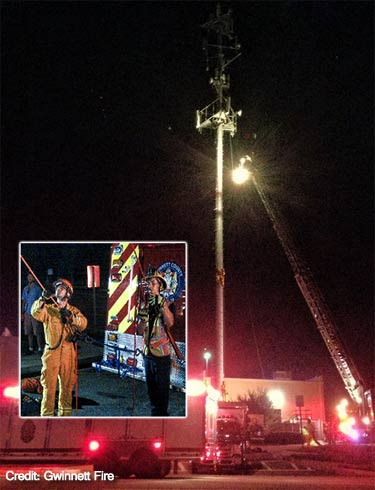 night. night.
In a news release, Gwinnett Fire Capt. Tommy Rutledge said the man was a member of a tower crew working at the 2101 Norcross Parkway tower site.
The man reportedly lost his grip on a step bolt, and had been suspended unconscious for a time before rescuers arrived. He was conscious on the tower platform when first responders arrived.
“He was saved by his cable grab system, which stopped his fall of approximately 15-20 feet,” Rutledge said in the release. “He struck the tower and was suspended unconscious by his personal rope. He regained consciousness after an undetermined amount of time and was able to lower himself a short distance to an elevated platform on the tower.”
His co-workers from Deep South Communications of Baton Rouge, LA called 911 at approximately 9:50 p.m. when he fell. The tech was on the ground at 11:00 p.m.
Rutledge said the department’s Technical Rescue Team was called in for “high-angle rope rescue operations.” A ladder truck was able to reach high enough to contact the man, but was not able to retrieve him.
The man complained of a shoulder injury. He was transported to Gwinnett Medical Center for further evaluation of what officials describe as non-life threatening injuries.
According to a person knowledgeable about the accident, the crew was working for Ericsson.
The owner of the tower was not immediately known.
There have been a number of rumors of tower climber fatalities within the past two weeks. Wireless Estimator cannot confirm any of them.
Although authorities in Charlotte, NC continue to investigate the death of a man who fell from a cell tower on June 4, 2014 in midtown Charlotte and was found at the base of the self-supporting structure, it is known that it is not industry related, and most likely a suicide.
Tying off emphasized by task force
In order to educate industry stakeholders, The Wireless Industry Safety Task Force recently unveiled the first in a series of public service announcements promoting their 100% Tie-Off 24/7 Awareness Campaign.
Participating companies and organizations affirming their commitment to the campaign include:
Alcatel-Lucent, American Tower, AT&T, Bechtel, Black & Veatch, Crown Castle, Ericsson, General Dynamics, Goodman Networks, Jacobs, MasTec Network Solutions, Motorola Solutions, National Association of Tower Erectors, Nexius, Nokia Solutions and Networks, SAI Communications, Samsung, SBA Communications Inc., Sprint, T-Mobile, U.S. Cellular, Velocitel, Verizon Wireless and WesTower Communications.
The task force web site page can be found here.
|
May 22, 2014 – The president of AT&T’s network operations, William Smith, said during a presentation at PCIA’s annual convention in Orlando that his company’s pending acquisition of DirecTV won’t affect how the carrier invests in its network buildout. But he didn’t address a construction detour due to new site builds  reportedly being put on hold this week. reportedly being put on hold this week.
According to executives of two of AT&T’s primary integration contractors, AT&T has notified them that new site builds scheduled for 2014 that are not shovel-ready are being put on hold, and 2015 projects have also been deferred as the carrier reanalyzes its budget.
“I don’t believe that they’re not going to do these planned sites, they’re just delaying them and handling other priorities,” said a turfing contractor vice president. An AT&T representative said he could not comment on the company’s plans.
Although the stoppage will not affect AT&T’s Project VIP initiative requiring close to 1,000 tower crews, it will have an effect upon contractors who have been awarded new build projects.
In addition, companies that have already purchased many millions of dollars in materials to build the new sites will be seeking additional compensation from AT&T.
A tower manufacturer sales representative said he hasn’t heard of any AT&T order being put on hold, but said if it’s just a deferral it would actually be helpful.
“Right now we’re slammed,” he said. “We’re having problems getting our orders out the door and this could benefit us.”
After vertical realtor executives were questioned whether the DirecTV acquisition could affect their business during Tuesday’s session, The View from the Top, W. Benjamin Moreland, President and CEO of Crown Castle International said his initial reaction was that it wouldn’t, and it might even provide ancillary benefits to tower owners.
Brenden Cavanagh, Executive VP and CFO of SBA Communications and Rodney Smith, Senior VP and CFO of American Tower’s US Tower Division, seemed relieved that that Moreland fielded the question and simply stated that they agreed with his analysis.
In his keynote speech, AT&T’s Smith said, “Don’t be concerned that this is a left turn by AT&T.”
“One of the advantages, or one of the reasons to put these companies together, is because more and more people are looking at content on their mobile devices,” Smith said.
AT&T on Sunday announced a merger with DirecTV valued at $48.5 billion, which led to speculation that Dish could be a target for Verizon as it looks to keep pace with its biggest competitor. However, Verizon CEO Lowell McAdam said that his company has had no talks with Dish and no interest in buying a satellite-TV provider.
The DirecTV deal will provide AT&T an opportunity to rapidly expand TV services along with its wireless and broadband services and allow it to enter additional lucrative markets in Latin America, where DirecTV is the leading pay-TV provider with over 18 million subscribers.
Although there was considerable conjecture at PCIA that the new build hold might be due to financial concerns regarding the $48.5 billion buyout, AT&T will likely benefit from DirecTV’s significant cash flow.
When asked at an investor conference why AT&T went after DirecTV and not Dish Network, AT&T CFO John Stephens said DirecTV had better distribution, content, and network, and Dish raised a lot more regulatory red flags.
“Dish has been very loud about their intentions to get into broadband,” Stephens said. speaking at an investor conference. He noted that AT&T feared that potential services overlap, along with Dish’s plans to use its spectrum for wireless, would raise more regulatory concerns.
|
Industry's most successful Positions Wanted board gets even more powerful
May 12, 2014 – Human Resources directors spoke and Wireless Estimator listened 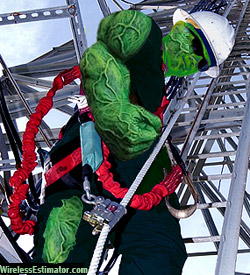 – very carefully – and restructured the nation’s most popular Positions Wanted Board to be the leading employment tool not available elsewhere in the country. – very carefully – and restructured the nation’s most popular Positions Wanted Board to be the leading employment tool not available elsewhere in the country.
In addition, it now provides wireless workers with a platform that will get their resume in front of more employers than all other industry web sites combined.
Some of the many advantages of the new design introduced are:
- The ability to immediately see the potential employee’s residence State and years of experience (for all new resumes)
- The capability to categorize candidates by regions of the country
- An employer’s private up to 5 Star Rating system to assist in selecting only the best candidates
- A listing of resumes viewed
- Additional filtering capabilities of dates posted and candidate ratings
- Lightning fast views of available candidates
- Provides the ability to capture the resume in a pdf and save it, or send the URL link to other hiring professionals or management
- An easily navigated resource that doesn’t hijack viewers to parts unknown
- A submission system that will allow posters to design, view and submit their professional looking resumes, or easily paste them from an existing Word or other document.
Wireless Estimator also provides the nation’s most comprehensive and effective Help Wanted resource. With more wireless infrastructure opportunities available than all other web sites combined, workers can view more than 400 job offerings each month in an easily navigated state-of-the-art job board.
Both the Positions Wanted and Help Wanted resources are available at no charge to industry employees and employers.
|
Tower erector “Cisco” Francisco passes away leaving a legacy of assisting many contractors
May 2, 2014 – Robert “Cisco” Francisco, of East Syracuse, NY, passed away April 27, 2014 at age 83, leaving a legacy of many tower company owners who learned their craft from the affable tower erector whose friendship encouraged them to advance industry safety and professionalism.
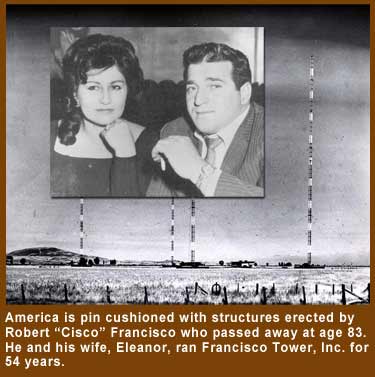 In the 1950s when Elvis Presley was gyrating his hips on TV, Cisco was orchestrating broadcast TV antenna picks as America began its love affair with color television. In the 1950s when Elvis Presley was gyrating his hips on TV, Cisco was orchestrating broadcast TV antenna picks as America began its love affair with color television.
Cisco, according to his wife Eleanor, enlisted in the Merchant Marine when he was 13 with a dubious birth certificate. The first ship he was on sunk off the coast of Venezuela, but he was fortunately rescued by a passing vessel.
When he returned from his sea service, Cisco opted for a profession that would keep him far removed from visiting Davy Jones’ Locker, but his chosen occupation was even more dangerous, although it too required using a bosun’s chair.
Cisco started a steeplejack business in 1954, and many of his jobs involved painting broadcast towers. However, Cisco was industrious and quickly learned the tower erection business, and he formed Francisco Tower, Inc. which became one of the go-to-contractors for tower manufacturers Stainless and Rohn for many years.
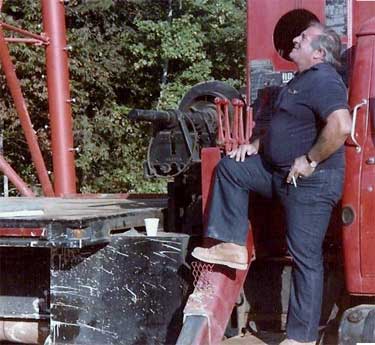 But the company’s success was also shepherded by a young 23-year-old woman he met when he was the same age, Eleanor Edwards, who he married 59 years ago and endearingly called “the love of my life”. But the company’s success was also shepherded by a young 23-year-old woman he met when he was the same age, Eleanor Edwards, who he married 59 years ago and endearingly called “the love of my life”.
“We met by chance when my boyfriend introduced me to him,” said Eleanor who recalled she was smitten the first time they looked at each other.
“I knew right then, this was going to be my husband,” she said.
Cisco was also taken in by the outgoing and extremely attractive Native American Mohawk Indian, and at the same time President Dwight Eisenhower was proposing to build an interstate highway system, Cisco proposed to Eleanor.
“I used to climb at that time,” said Eleanor, as she reflected upon the many years and adventures she and Cisco shared together.
“I remember one time that I was painting a tower and I was about 300 feet up in the air when a union steward came on the jobsite because he had heard that there was a woman working there and they wanted to kick me off the work,” said Eleanor.
“When he came by, he asked the ground guy where the woman was because he wanted to talk to her. He was told that she would be happy to talk to him, but he was going to have to climb up a few hundred feet to do so. He left, but I wasn’t concerned because I had a union card at that time.”
Eleanor said she enjoyed climbing with Cisco, and was frequently on a tower.
“I did, however, have to tag when I was pregnant,” she said.
Cisco was known for his wit and friendly nature, said Eleanor. “He was always kidding. He would tell people that he wouldn’t let me run the winch when he was on the tower because I might take the opportunity to drop him,” she said, recalling the enjoyable banter that rounded their relationship.
Cisco was one of the early contractors to build broadcast towers as additional structures were required to satisfy all of the new stations that began broadcasting in the 1950s and 1960s.
“There weren’t too many companies doing it then,” said Eleanor. “There was Bill Ellis, Pop Tiner, Jimmy King, Jim Meehan and a few others, but many of them have passed away. When there was a big job they would call upon each other to get it done.”
In later years Cisco joined the National Association of Tower Erectors and began to embrace the need for working more safely.
“But in the early years we never tied off,” said Eleanor. “I never wore any fall protection equipment when I started. I would just get up there and twist my leg around the tower.”
Neither did Cisco who climbed unprotected, oftentimes in severe weather conditions.
Cisco was comfortable traversing tower members, and according to his daughter, Ronnie, he almost made it an art form.
“Of course I am biased, but over the years, I have seen many climbers on towers and bridges and my dad was among the few who were truly magnificent to watch. He moved with speed, agility and grace,” she said.
Cisco and Eleanor closed their business in 2008 after the erection industry became more cell-tower-concentric.
In addition to Eleanor, Cisco is survived by two brothers, Raymond and Claude Woolridge; his seven children, Daren, Tewantesere, Roberta, Kia, Robin, Ronnie and Nicole; several nieces and nephews, 17 grandchildren and 16 great-grandchildren.
A memorial service will be held at St. Lucy's Church, 432 Gifford Street, Syracuse, NY on Friday, May 2, 2014 at 10 a.m. Contributions can be made to Hospice of CNY, 990 7th North St., Liverpool, NY 13088.
|
State-of-the-art Emergency Services Locator hits a 12-month record of rolling over 100,000 jobs
April 30, 2014 - More than 100,000 of the nation's wireless construction and maintenance projects have been rolled in the past 12 months using Wireless Estimator's Emergency Services Locator, a unique tool that is not available anywhere else in the country.

The huge industry-wide adoption rate of the ESL is because the proprietary leading edge program ensures within minutes that information will be available to immediately contact emergency services and quickly identify the nearest acute care hospital -- a daily jobsite requirement to be OSHA compliant.
The milestone 12-month record of 107,747 compliance documents, completed as of April 28, 20014, saw 12,050 forms completed just within the past month, up 1800% since the interactive compliance module was introduced four years ago.
“When we first announced the ESL in February of 2010, we were thrilled by its immediate acceptance with 677 projects being rolled in its first month,” said Craig Lekutis, president of Wireless Estimator, who worked closely with his programmer and the country’s foremost safety executives for over six months before launching the free locator service and the industry’s most respected Job Hazard Analysis forms.
Success is “overwhelming”
“With over 12,000 individual jobs being rolled in the past 31 days, we’re overwhelmed by the module’s success,” Lekutis said, attributing the remarkable acceptance and usage of the ESL to “its extreme functionality and ability to quickly access the jobsite’s location, fire department locations and telephone numbers as well as police department and sheriffs office information, along with the nearest acute care hospital complete with a map and driving directions.”
What used to take administrators and managers up 20 minutes or more to capture this information through oftentimes misleading internet searches is now a two to three minute process not available elsewhere.
Once an address is inputted into the form, three search engines, Google, Bing and Yahoo, let users know where they found the site. In most cases, their location markers are directly on top of each other, identifying pinpoint accuracy. However, on occasion one or all of the mapping services cannot locate the address due to the way it is written or because they do not recognize the address at all.
Although all information entered into the form remains confidential, Wireless Estimator does show where the jobs are being rolled within the country, a useful tool for industry-wide analysis.
California leads the top 10 states
The ESL provides either emergency services information or it can be auto-filled in a Jobsite Hazard Analysis form that was developed through the efforts of over two dozen of the industry’s leading contractors and national management firms’ safety managers to ensure a best of best JHA that meets and exceeds the requirements of industry standard ANSI/TIA 1019.
Users can select either a JHA where the job requires elevated work above six feet, or a JHA providing the details required for service and civil work. The majority of jobs rolled in the nation are using a Wireless Estimator provided JHA. Samples of those forms can be viewed here.
The top 10 highest states where administrators, supervisors, managers and others start their projects off with a Wireless Estimator ESL and/or JHA form are: Calif., Ill., Ind., Wash., Ga., Pa., N.Y., Tex., Ohio, and Mich.
“That doesn’t necessarily identify where the majority of the work is being performed, although it is a good barometer,” said Lekutis. “The usage could also be affected by state and federal OSHA enforcement, and an increased culture of safety compliance of companies operating within those states.”
Even with a completed JHA you can still be cited
When there is a serious injury or fatality, one of the first investigations performed by an OSHA inspector is to ensure that emergency services information was available to workers on the site as well as a completed and detailed JHA.
Earlier this month, OSHA cited Pinpoint Towers, LLC for failing to conduct a comprehensive job hazard assessment after a tower technician fell to his death in Kansas on Nov. 23, 2013.
A representative of Pinpoint said that a JHA was on site and was more than adequate, and that the citation would be vigorously contested.
|
It’s now simply search and select
Wireless Estimator simplifies the industry’s training course selections
April 30, 2014 – Wireless Estimator’s newest version of its popular training resource locator will now allow users to easily search any region of the country to quickly  identify the companies and the hundreds of available courses that best suit their employees’ needs. It also features virtual and on demand offerings to assist companies in minimizing expenses and travel time. identify the companies and the hundreds of available courses that best suit their employees’ needs. It also features virtual and on demand offerings to assist companies in minimizing expenses and travel time.
Here are just a few of the new enhancements that have been introduced:
Filter by region and company
Users can now identify training companies by region - the most often requested addition by the nation’s training firms so that their current and potential clients can take advantage of reducing the travel time and expenses of enrollees.
Viewers can also easily filter and select the industry’s most widely respected training companies, and only have their offerings appear on the user-friendly resource search tool.
Virtual and on demand offerings
Visitors can effortlessly see the online courses available to complement their training requirements in the Anywhere…Anytime Training opportunities. And companies capable of providing on-site or on-campus training now have a showcase to target readers with their on demand listings.
Navigation that would make Magellan proud
Decision-making readers are too busy to be searching the internet for training organizations and schedules. Wireless Estimator’s training resource now does that for them.
And most importantly, when they’re on the training solutions page they stay there since it’s not necessary to take a confusingly frustrating page-to-page road trip detour as they’re required to do elsewhere.
Take the resource locator for a test drive. We promise you’ll love the smooth ride.
|
New Jersey tower tech takes his life by jumping off a 400-foot tower he had previously serviced
April 23, 2014 – It may never be known why a 60-year-old tower technician committed suicide Monday evening by jumping off of a tower he had previously worked on 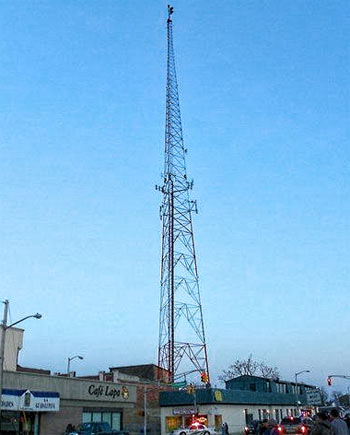 performing a Verizon project a week before in Long Branch, N.J. performing a Verizon project a week before in Long Branch, N.J.
According to authorities, Pedro Macias from Elizabeth was on the tower for approximately an hour before he jumped. He worked for National Microwave Contractors, Inc. of Rockaway.
As seen in a video taken by a bystander, Macias climbed the tower with his personal fall protection equipment on, stopping briefly for a cigarette break, and then proceeded to climb to the top mast which supported Y107’s antenna and an incandescent beacon on the 400-foot self-supporting tower.
He hooked up his lanyard and remained there for a while, swinging from side to side. He then stared at the crowd which had gathered on the sidewalk outside a ring of emergency vehicles, unhooked his harness and threw himself off of the tower with his feet pointed at the ground and his hands raised in the air.
He went through the roof of a vacant building, dying upon impact. Police and firemen could not immediately enter the building as it was deemed unsafe. After a hole was cut in the side of the structure he was lowered to the ground.
Macias had been a tower technician for more than 15 years and was originally from Cuba. He had either climbed the tower compound’s fence or may have had a key to access the gate as there were no signs of a break-in.
Long Branch Director of Public Safety Jason Roebuck said that he had been in touch with National Microwave and they had stated that they had no record of Macias doing any maintenance on the tower on Monday.
The tower is located at Memorial Pkwy. and Belmont Ave.
|
American Tower acquires Richland Towers’ tall tower assets in a $350 million deal
April 18, 2014 - Tampa, Fla.-based Richland Towers, the U.S.'s largest privately owned tall tower company, has been acquired by American Tower Corporation for an estimated $350 million, according to sources familiar with the transaction.
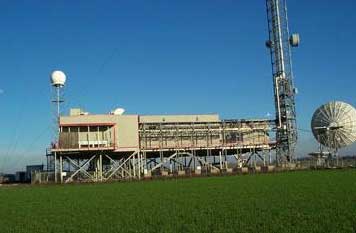 Approximately 50 towers were involved in the deal which is expected to be discussed during ATC’s first quarter conference call scheduled for May 1, 2014. Approximately 50 towers were involved in the deal which is expected to be discussed during ATC’s first quarter conference call scheduled for May 1, 2014.
Richland Towers, owned by John Bray, had Barclays solicit proposals last year for his tall tower portfolio. Bray was seeking approximately 15 times cash flow, according to an investment banker familiar with the deal, but settled earlier this year with American Tower for around 12 to 13 times tower cash flow.
Founded in 1996, Richland Towers began acquiring their prime properties during the implementation years of the federally mandated conversion to digital broadcasting for TV stations.
Last March, they purchased seven towers in five markets from Clear Channel.
They have four towers in Cedar Hill, Tex., a Dallas suburb where American Tower also owns a structure at the antenna farm community where there are 15 structures over 300 feet in height with Richland Towers’ 12-foot face guyed tower being the highest at 1,731 feet.
Their signature site is a 2,000-foot tall 10-foot face Stainless tower with a 20-foot elevated transmitter facility in Walnut Grove, Calif.
For a short while Richland Towers floated the idea of requiring all of their approximately 25 erection and maintenance companies to have all of their crew members become certified as having taken TIA 1019 training, but they later abandoned the safety initiative which was supposed to take effect in 2014.
|
Pinpoint Towers hit with a $21,000 fine for violations involving worker’s death
April 15, 2014 - The U.S. Department of Labor's Occupational Safety and Health Administration has cited Optica Network Technologies, which it states in a press 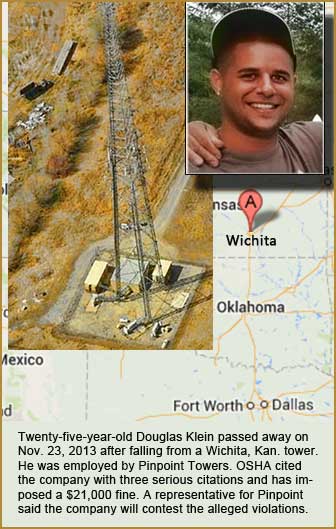 release operates as Pinpoint Towers LLC, with three serious safety violations after a worker was fatally injured during a fall from a communications tower on Nov. 23, 2013 at a work site in Wichita, Kan. release operates as Pinpoint Towers LLC, with three serious safety violations after a worker was fatally injured during a fall from a communications tower on Nov. 23, 2013 at a work site in Wichita, Kan.
Twenty-five-year-old Douglas Klein was performing maintenance when he fell about 50 feet while descending the tower. As a result of the investigation OSHA issued three serious citations to Pinpoint.
The citations allege that Pinpoint failed to ensure fall protection was maintained at all times while traversing the tower, and did not conduct a comprehensive job hazard assessment to include fall protection methods prior to employees traversing the tower. Finally, OSHA states, the company failed to provide certification that the hazard assessment had been completed and did not provide adequate fall protection training to workers.
A serious violation occurs when there is substantial probability that death or serious physical harm could result from a hazard about which the employer knew or should have known.
Director of Safety and Training for Pinpoint Services, Inc., Ed Dennis, said that there was a comprehensive JHA on site and the citations will be vigorously contested.
OSHA has proposed penalties of $21,000. Pinpoint has 15 business days from receipt of the citations to comply, request an informal conference with OSHA's area director in Wichita or contest the findings before an administrative law judge.
The average wireless industry construction fine issued over the past ten years is $8,275, according to an analysis by Wireless Estimator.
A number of industry professionals believe it’s too low. Almost four years ago the average fine was $6,100 at a time when the national average was $11,300.
In making the citations announcement, Michael Moon, OSHA’s acting area director in Wichita said, “"All employers, and especially those in high-hazard industries such as communication tower construction and maintenance, must properly train their workers on the need to maintain fall protection at all times."
Last November, James Maddux, Director of OSHA’s Directorate of Construction, informed his area directors that when workers are not using effective fall protection, “the fall hazards are obvious, well known and potentially fatal. In appropriate case, area directors should work closely with their regional solicitor to develop willful fall protection citations.”
Moon and his solictor’s decision to ignore Maddux’s directive is not known and OSHA will not comment upon ongoing investigations and contested citations.
A serious citation against B-Mack Wireless regarding a worker’s death in Indiana in the amount of $2,500 was reduced on March 14, 2004 during an informal settlement.
North American Power Line Construction Services contested three serious citations totaling $7,000 issued after a company worker died in Washington last year, but withdrew their request and agreed to pay the fine on Feb. 24, 2014.
|
Rescuers and a lanyard help save a tower
technician's life in Charlotte, North Carolina
 Update: April 12, 2014 - John Laughter, the co-owner of Communications Logistics Services LLC of Bostic, NC said his employee, Daniel Hopey, who had to be rescued Update: April 12, 2014 - John Laughter, the co-owner of Communications Logistics Services LLC of Bostic, NC said his employee, Daniel Hopey, who had to be rescued 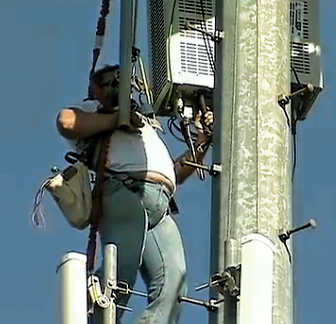 by firefighters last Thursday after he was immobilized on a 150 foot monopole, did not fall from his work station. by firefighters last Thursday after he was immobilized on a 150 foot monopole, did not fall from his work station.
"He shifted his body and tried to reach over to perform his task, and when he did he slipped out of his butt harness all the way down into full leg lanyards. Once you get yourself into that position - if you've never been there before you don't understand - there is no flipping uside down. I don't care how strong you are you are not doing a pull up," Laughter told WSOC-TV in a phone interview.
Update: April 11, 2014 - Tower technician Daniel Hopey, who was rescued by firefighters yesterday, was a member of a two man tiger team that was troubleshooting for
Sprint and Ericsson, according to two individuals knowledgeable about the rescue. The structure is owned by Cro
wn Castle International.
- - - - - - - - - - - -
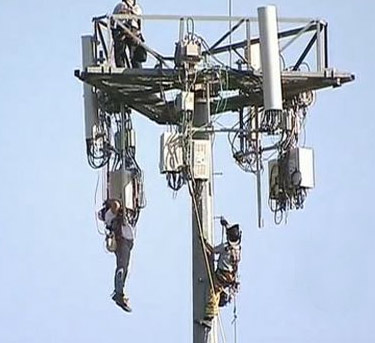 April 10, 2014 - The proper usage of fall protection equipment and two Charlotte, April 10, 2014 - The proper usage of fall protection equipment and two Charlotte,
NC firefighters helped to save the life of a tower technician who fell while performing maintenance on a monopole late this afternoon.
According to news reports and available video, the tech was working alone on the tower when he fell and hanged from his safety harness and lanyard for over an hour. A co-worker on the ground called 911.
The rescue at the 3800 block of Shamrock Dr. tower in East Charlotte was by Charlotte Fire Department Captain Joel Cherry and fireman Kevin Walling who climbed the two-tenant tower to the top platform to pull up the worker who was hanging about 10 feet below.
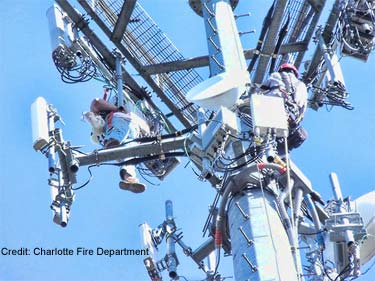
"He was very happy that we were there to get him. He told me he had two kids at home, or one kid and one on the way. He really wanted to get home to them," Cherry told WBTV.
After resting a short while the tech started to climb down the monopole, but was then lowered the rest of the way to the ground to waiting firefighters. He was taken by ambulance for evaluation, although his rescuers said that they didn't appear serious.
He reportedly suffered minor injuries and had some pain caused by the lack of circulation to his legs as he hung in his harness.
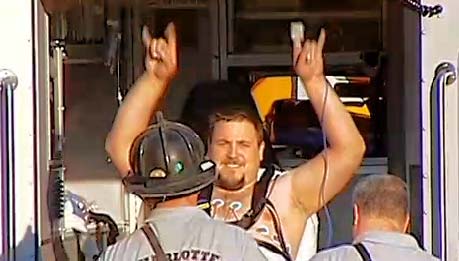
His name and the company he was employed by as well as the carrier he was performing work for was not immediately available from fire department spokesman Mark Basnight.
Wireless Estimator will provide additional details when they become available.
|
|
Sprint raises its 2015 Clearwire cell site shuttering to at least 6,000 locations
April 9, 2014 – According to a Securities and Exchange Commission filing, Sprint 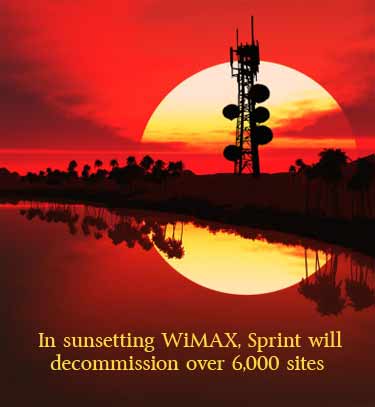 expects to decommission at least 6,000 cell sites by the end of 2015 as part of its plan to shut down WiMAX service. When the carrier announced last fall its plan to sunset WiMAX as it moved to LTE technology their redundant Clearwire sites totaled 4,300. expects to decommission at least 6,000 cell sites by the end of 2015 as part of its plan to shut down WiMAX service. When the carrier announced last fall its plan to sunset WiMAX as it moved to LTE technology their redundant Clearwire sites totaled 4,300.
Clearwire, acquired by Sprint last July, had deployed WiMAX technology on approximately 17,000 cell towers and other structures and was in the process of deploying 4G LTE technology using the 2.5GHz spectrum on approximately 5,000 of those sites, which has now been completed, according to Sprint.
The carrier said it plans to expand the 2.5 GHz 4G LTE deployment to approximately 5,000 more legacy Clearwire sites.
Sprint pegged the lease exit costs to be between $50 to $100 million. Sprint estimated last year that it would be between $75 to $100 million.
Sprint said they expect the majority of their efforts to roll out 4G LTE on their 800 MHz and 2.5 GHz spectrum bands to be completed by the end of 2015.
Last October, they announced Sprint SparkSM , which is an enhanced LTE network capability that analyzes their three spectrum bands of LTE and connects a device to the most optimal band available in the area.
The deployment period for this technology is projected to correspond with the roll out of 4G LTE on their 800 MHz and 2.5 GHz spectrum bands.
The cost to complete these initiatives to modernize their network will be significant. They expect capital expenditures of approximately $8 billion in 2014, according to company documents.
|
|
Two techs are dead following the collapse of two guyed towers in Kansas
Update: March 26, 2014 - The deceased tower technicians who died on Tuesday in Pottawatomie County have been identified by the sheriff's office as 38-year-old Martin Powers of St. Charles, Mo. and 25-year-old Seth Garner of St. Peters, Mo. Powers was pronounced dead at the scene, and Garner was transported to a local hospital where he was also pronounced dead.
Update: March 26, 2014 - Authorities have not released the names of the two tower technicians who died yesterday after two towers collapsed in Blaine, Kan., but according to sources 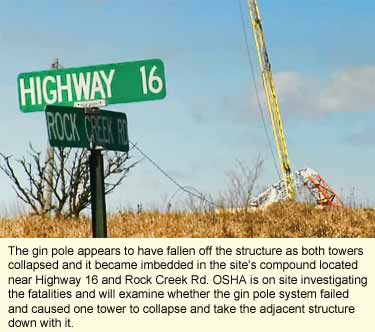 investigating the accident, the deceased workers were age 38 and 25 and resided in Missouri. They had been employed by Wireless Horizon for less than five months. It is not known whether they had prior tower construction experience. investigating the accident, the deceased workers were age 38 and 25 and resided in Missouri. They had been employed by Wireless Horizon for less than five months. It is not known whether they had prior tower construction experience.
Update: March 25, 2014 - The two technicians who died this morning were employed by Wireless Horizon, Inc. of St. Peters, Mo., according to personnel knowledgeable of the accident. Wireless Horizon has been providing communications construction services since 2000.
In 2005, a Wireless Horizon employee was killed in Illinois after a jumped gin pole began sliding down the tower face and abruptly stopped when it was caught by the load line headache ball. The technician, who was climbing the gin pole when it happened, was thrown from the pole and fell 120 feet. Wireless Horizon was cited with a Serious violation by OSHA and fined $1,500, but had the fine reduced to $750 in an informal settlement.
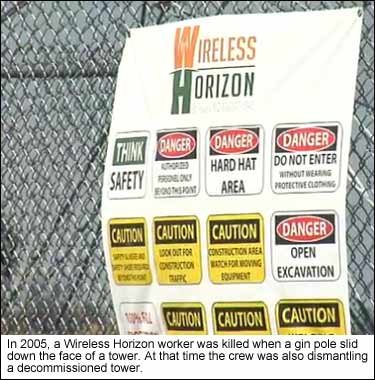 Both today's and the 2005 accident occurred while the company was decommissioning a tower and dismantling it with a gin pole. Both today's and the 2005 accident occurred while the company was decommissioning a tower and dismantling it with a gin pole.
Michael Moon, acting director for the Wichita area OSHA office, said his personnel were investigating the the fatalities. He also stated that he was aware of Assistant Secretary of Labor David Michaels' recent request to target the wireless construction industry due to the alarming increase in worker deaths.
Last week, Michaels asked for a national safety stand-down from June 2 to 6 to raise awareness among employers and workers about the hazards of falls, which account for the highest number of deaths in the construction industry.
- - - - - - - - - - - - -
March 25, 2014 - Two tower technicians were killed when two towers collapsed in Blaine, Kan. The Pottawatomie Co. Sheriff's Office said the structures fell about 9:30 a.m. near the junction of Highways 16 and 99.
A spokesperson for Union Pacific Railroad, the owner of the guyed towers, said the techs were removing a 256-foot tower that was no longer in service when the accident occurred. The older tower had been constructed in 1985, according to the FCC's database.
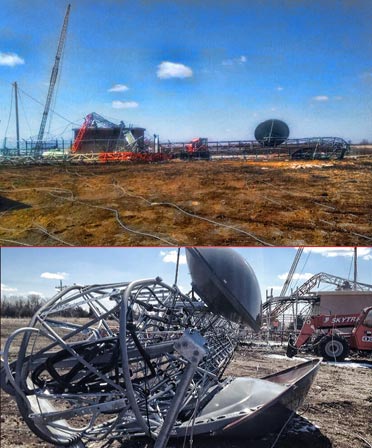 Aaron Hunt also stated that the two workers were very experienced. Aaron Hunt also stated that the two workers were very experienced.
County Fire Supervisor Bruce Brazzle said four people were working at the site and the deceased techs had been on the older tower when it collapsed.
One tech was pronounced dead at the scene and another was transported to a local hospital where he was pronounced dead, said Pottawatomie County Sheriff Greg Riat.
Both technicians were at approximately 250 feet on the guyed tower when it fell, according to Riat.
Blaine is located about 50 miles northwest of Topeka.
The workers' company was not immediately available and the names of those killed were withheld until their families are contacted.
Photographs taken by WIBW show what could be a gin pole lodged in the ground within the tower compound. It is unknown if a failure of the gin pole system contributed to the accident.
Two technicians died last year in Georgetown, Miss. when a gin pole plummeted as it was being raised to the top of 300-foot guyed tower.
OSHA is investigating the accident.
Wireless Estimator will provide additional details when they become available.
Last Wednesday, a tower technician died in Maryland when he fell off of a water tower. Today's deaths raised this year's fatality count to six.
|
|
Big is back again as better
AT&T’s tower crew program could shape up
as an industry game changer
 March 25, 2014 – AT&T’s Tower Crew Augmentation Program (TCAP), a plan designed to provide the carrier with a quicker and more quality-driven build-out, could adversely affect the contracting landscape of smaller tower construction companies if its rollout proves to be successful. It might also cut into Verizon’s 4G March 25, 2014 – AT&T’s Tower Crew Augmentation Program (TCAP), a plan designed to provide the carrier with a quicker and more quality-driven build-out, could adversely affect the contracting landscape of smaller tower construction companies if its rollout proves to be successful. It might also cut into Verizon’s 4G 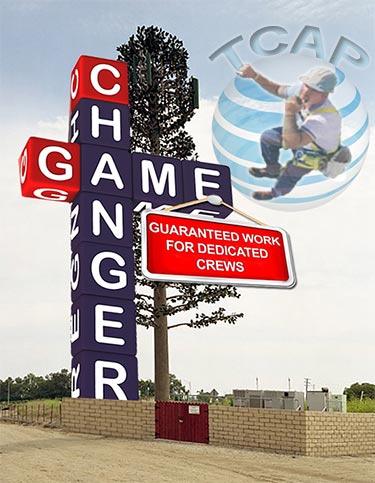 construction lead. construction lead.
TCAP, according to knowledgeable executives, who spoke on the condition of anonymity, is a program that will assist the carrier in capturing additional dedicated tower crews it needs to build out its network.
“It began towards the end of last year and is an agreement to provide services directly to AT&T or to supplement their current turfing vendors who cannot support their ambitious build-out program with available crews,” said a person familiar with the strategy.
Details about the program are limited since AT&T has not responded to multiple requests for information about TCAP, and has made it clear to contractors that they are bound by their non-disclosure agreement.
However, it is has been stated by a number of industry insiders that AT&T has a contract in place with MasTec Network Solutions to provide crews for the Eastern part of the country, Ericsson for the West and BlueStream Professional Services for the Midwest, Southwest and Great Plains, in addition to markets the companies are already providing services in under other agreements.
Dedicating tower crews is not a novel approach and has been used by carriers for a number of years, but the TCAP program appears to provide added benefits with the primary advantage being assured work for each dedicated crew. In addition, pricing appears to be more equitable than in previous years.
In the past, AT&T’s and its vendors’ inducement to obtain contractors was to award multiple projects, but when there were equipment delivery issues, market adjustments or permitting problems, contractors would oftentimes go for weeks without any work.
TCAP’s benefit to AT&T will be continued access to installation resources to build out their system to lessen Verizon’s lead in their LTE coverage.
An ancillary value, equally as important to AT&T, will be quality control. (Continued)
Please see: A reduction in tiger teams
|
|
Maryland accident claims the life of another tech
Update: March 21, 2014 - Anne Arundel County fire officials have identified the 21-year-old man who was killed after falling from a 180-foot water tower Wednesday afternoon in Pasadena as Chad Louis Weller of Stevensville.
A spokesperson for his, employer, Redwing Electric of Fairfield, N.J., said the company did not have any information available for publication at this time.
Weller had received climber training and was a competent climber, but according to individuals knowledgeable about the accident, he was not tied off when he fell.
Services will be held on Monday, March 24, 2014, at 1 p.m. at Fellows, Helfenbein & Newnam Funeral Home, 106 Shamrock Road, Chester, where friends and family may visit from 11 a.m. to 1 p.m.
----------
March 19, 2014 - A 21-year-old tower technician was pronounced dead at a communications tower site after he fell approximately 180 feet from a water tower in Pasadena, Md., according to a press release issued by the Anne Arundel County Fire 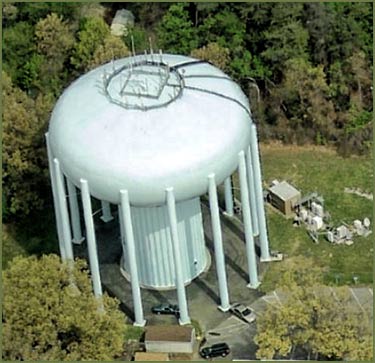 Department. The man, whose name hasn’t been released, was the industry’s fourth fatality in 2014. Department. The man, whose name hasn’t been released, was the industry’s fourth fatality in 2014.
After arriving at the scene, fire personnel found the worker unconscious and unresponsive and worked aggressively to resuscitate the worker.
The accident happened about 2:30 p.m. at the site adjacent to a self-supporting tower located behind the Eastern District Police Station and Jacobsville Fire Station. A rain shower had been reported in the area today. At the time of the accident wind gusts were less than 5 miles per hour.
The incident is currently under investigation by Maryland Occupational Safety and Health (MOSH). The identity of the worker is being held pending notification of the next of kin.
Authorities did not release the name of the worker’s employer.
Wireless Estimator will provide updates when they become available.
|
Industry is quick to weigh in with their
comments following Hang Men’s debut
Commentary
 March 15, 2014 – Realty TV has no bounds and a recent successful entry is Game of Arms, an unscripted program about arm wrestling – a wristy business. So it was no surprise that the Discovery March 15, 2014 – Realty TV has no bounds and a recent successful entry is Game of Arms, an unscripted program about arm wrestling – a wristy business. So it was no surprise that the Discovery 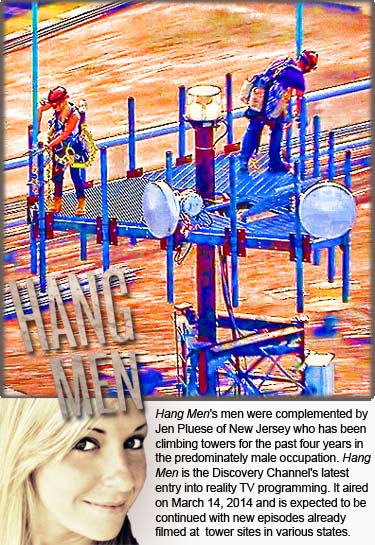 Channel saw the profit potential of riding on the shirttails of tower erection and maintenance – a risky business - and they premiered Hang Men last night to mixed reviews. Channel saw the profit potential of riding on the shirttails of tower erection and maintenance – a risky business - and they premiered Hang Men last night to mixed reviews.
The program followed two crews from Tower & Wireless Construction Co., a subsidiary of Old Bridge, N.J.-based SubCarrier Communications as they installed antennas in Linden, N.J. and Harrisburg, Pa.
Even before it hit its first commercial, some Facebook posters were stating that it didn’t adequately represent the industry.
Since the reality show was produced by Electus, an entertainment company far removed from objective journalism endeavors, it was never expected by most industry professionals that the one-hour pilot would hold true to all industry best practices.
Although there were some safety infractions in the trailer promoting the show and possibly in the premiere itself, Subcarrier’s owner, John Paleski, frequently emphasized the need for all of his crew members, outfitted in spotless PPE, to be vigilant in observing safety requirements throughout the show.
A connected DBI-SALA cable sleeve was seen so often the safety company’s marketing execs were probably doing early-morning high fives.
Flash back to NBC’s Tower Dogs broadcast six years ago and it’s obvious that Hang Men presented a more professional view of tower climbers.
There were no bar scenes, drunken monologues, dysfunctional workers and overriding publicity about this being “the most dangerous job in America”. Hang Men at least tempered it with “one of the deadliest professions”.
One similarity was a featured female climber, an almost obligatory requirement for attracting viewers, especially if the tower tech is attractive and fit like Jenny who has been climbing for four years in an industry where women climbers can be counted on a crew’s hands and toes.
Diddy, Jessie, John, 40-Watt and others featured in Hang Men are the cement that will hold this show together.
Although Jenny seemed to be too concerned about transitioning to an antenna platform during the show, something that one would expect she should have already done dozens of times before, that observation is fostered by industry knowledge.
In assessing the program, it’s important to note that it wasn’t made for the industry any more than ER was hoping and reliant upon capturing practicing physicians.
Whether the tower business adores or abhors it, its success will come from whether or not it plays to the public in Peoria. And Peoria might like it.
Six people, unaffiliated with the industry, watched Hang Men at Wireless Estimator’s request. They all found it to be interesting; five viewers said they would watch another episode.
Some comments were:
“I never thought about those towers and how my phone uses them.”
“It’s a dangerous job and they should be paid well.”
“I liked the explanations of what they were doing and never realized a signal could go so far.”
“I don’t watch reality shows because they bring out the worst in everybody. This was interesting.”
“That was the best documentary I've seen that illustrates the hazards and the contribution these guys make to the communications industry including the security of the nation.”
Hang Men did provide information that’s typically not discussed, such as the ability for a worker to make up to $120,000 or more, and the payment of $17,500 for a one day antenna and line installation. But it wasn’t asterisked with the fact that the work is being done in the New Jersey-New York Metropolitan Area with prevailing wage laws that can raise hourly wages to $45 or more and the worker might be getting 30 or more hours of overtime.
“There you go again,” Governor Ronald Regan might have said regarding that statement as he did with presidential candidate Jimmy Carter, cautioning us to consider that we’re looking at the program from an industry perspective and not as a member of the target audience.
Although there are sure to be those who believe that Paleski’s nausea and precarious situation on the tower from bee stings was a fabricated event, it did happen, according to a number of people on site during the filming who spoke with Wireless Estimator.
“There you go again.”
This is a reality TV show and it’s natural that the business will not always be presented in the best light, even though there are some issues that the industry needs to resolve. But it didn’t make us look like bumbling idiots like Tower Dogs did, which was looking to be spun off as a reality show, but thankfully never made it.
Presumably, the best show that would appease everyone would be a training film of the Harrisburg install with all crew members being hard-working local Pennsylvania Dutch tower techs, with no visible cleavage, who didn’t swear or become impatient as they covered their heads with a straw broad-brimmed ANSI approved hard hat and hitched up their regulation PPE suspenders.
And since they can’t drive, a drone camera wouldn’t catch them ever failing to walk a straight line during a sobriety stop or mistakenly putting high octane fuel in a diesel engine.
“There you go again.”
Electus is expecting Hang Men to continue with additional episodes. One episode was reportedly filmed in Alaska.
To view and offer your constructive comments about the program, click here .
|
|
Hang Men docudrama will put tower work’s dangers back in the spotlight on Friday
March 12, 2014 – NBC’s Tower Dogs, Frontline’s Cell Tower Deaths and Mike Rowe’s Dirty Jobs took the tower construction industry out of the shadows, but the profession will be cast in a brighter spotlight on Friday, March 14, 2014 at 11:00 p.m. eastern when Hang Men, an original presentation on the Discovery Channel, showcases the heroic work of the industry's men and women who build and maintain America's communications networks.
Whereas many 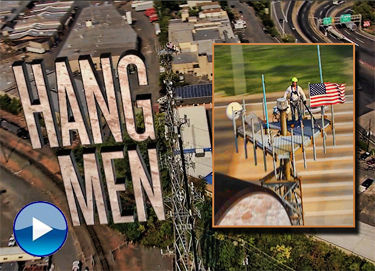 programs are discussed in social and other media months before their air date, Hang Men took the industry by surprise when the Discovery Channel announced the one-hour program yesterday afternoon with its promotional tag: “On Hang Men, tensions run high for John Paleski and his crew. Fighting tight deadlines and a slew of setbacks, it’s a battle with gravity to complete two risky antenna installations.” programs are discussed in social and other media months before their air date, Hang Men took the industry by surprise when the Discovery Channel announced the one-hour program yesterday afternoon with its promotional tag: “On Hang Men, tensions run high for John Paleski and his crew. Fighting tight deadlines and a slew of setbacks, it’s a battle with gravity to complete two risky antenna installations.”
The program will be repeated again on Saturday at 2:00 a.m. and 2:00 p.m. eastern.
A casual look at the promotional trailer suggests that the five-man Tower & Wireless Construction Co. crew, a subsidiary of Old Bridge, N.J.-based SubCarrier Communications, was struggling with two near accidents while they were installing an antenna.
"But this needs to be viewed within the context of the full pilot," said John Paleski, President of SubCarrier.
“In one scene of the trailer, a pipe mount fell off of a tower while my men were rigging it. What my crew couldn’t have known is that a crew from another company was going to remove the antenna mount and just left it hanging loose in its U-bolts and it fell, almost hitting a ground man as it smashed into a transmitter cabinet,” said Paleski, who is oftentimes frustrated when an incompetent crew is hired by a tenant to work on any of the 320 towers he owns.
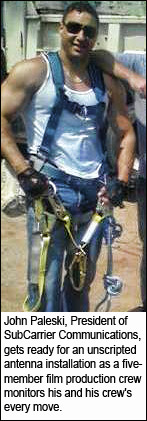 “The fact is that we're working in one of the deadliest professions in the world, and it's important that even laypeople, who may tune in for the entertainment value of the program, will recognize that the men and women involved are highly trained professionals who value safety above all else in this mentally and physically demanding field," said Paleski. “The fact is that we're working in one of the deadliest professions in the world, and it's important that even laypeople, who may tune in for the entertainment value of the program, will recognize that the men and women involved are highly trained professionals who value safety above all else in this mentally and physically demanding field," said Paleski.
Paleski, who hasn’t seen the program produced by Electus, said he believes that it will be a positive piece for the industry without any contrived footage.
“All wireless workers should be appreciated for the work they do. Not enough people know about the dedicated men and women whose daily efforts allow them to talk and stream on their 4G phones. They have no idea how it works. And without tower workers installing and maintaining these sites, the thing they carry around in their pocket would be nothing more than an expensive paperweight with a two-year contract,” Paleski said.
The title, Hang Men, was selected by the Discovery Channel, according to Paleski.
Paleski graduated from Rutgers University with a degree in economics. He began climbing in 1986 and appears in Hang Men. But it’s not a cameo appearance.
“I often climb with my men because I don’t ever want them to do a job that I couldn’t safely do myself.”
Paleski readily admits that when he first started climbing he only used a lanyard and a lineman’s belt. “For many years, before it became a popular industry catch-phrase, we’ve been committed to 100% tie-off at all times.”
The program was filmed in Linden, N.J. and Harrisburg, Pa.
Paleski is excited to have the public enjoy additional episodes of Hang Men in the near future.
|
|
On the lighter side…
International tower competition provides for the world’s tallest human shish kabob grill
March 5, 2014 – The Turkish seaport city of Canakkale has announced the winner of an international competition for a broadcast tower design that, if built, might eclipse visitor attendance to their wooden horse exhibit from the 2004 movie Troy – placed there because Canakkale is the closest city to the site of ancient Troy. But like the  Trojan horse, it’s hiding an elite and deadly RF force inside. Trojan horse, it’s hiding an elite and deadly RF force inside.
The winner for their supple 328-foot tower was design firm IND and Powerhouse Company. And although they noted that they worked with structural engineering firm ABT to make a circuitous loop through the forest, with an outdoor pedestrian walkway and indoor public spaces at the tower's base possible, electromagnetic radio frequency concerns appear to take a back seat in their racetrack-like design.
But IND didn’t have exclusivity on excluding pesky RF safety requirements since all other entries appeared to present exposure problems.
One entry shows a Mattel Hot Wheels-like observation pod that would take visitors on a trip up and down the interior of the looped tower within inches of the broadcast antenna’s elements, giving rise to the expected small print warnings on the ride ticket: “WARNING: Children under age 12 must know their specific whole body absorption rate and be accompanied by a RF badge. Intentionally exposing undergarments by sagging your RF attenuation suit pants to plumber’s crack levels or below is strictly prohibited. The adrenaline-rushing activity of throwing your hands up in the air is not recommended since it will create higher near-field exposure levels and can cause hot flashes in women as well as men.”
Sam Monitors is reportedly in negotiations with the tower theme park for the RF measuring device concession with its new unit, the Samsong S5.
It features a built-in alarm and visual system with 26 music alert videos such as country star Dwight Yoakam singing “Watch out, I never felt such pain,” and Super Bowl 2014 halftime headliner Bruno Mars belting out, “Feels like I'm on fire…My temperature is higher”.
Also available as an alert is a song from Rock and Roll Hall of Fame legend Peter Gabriel which might have the most uninspiring lyrics ever written, but possibly the most helpful for old-school climbers who must be told numerous times before safety messages sink in.
It’s obvious why. The song, from Gabriel’s album, Scratch, was Exposure, a word he used 13 times when he co-wrote the lyrics of the 27-word song.
If the wearer continues to ignore an overexposure alert for a set period of time of up to 12 hours, the less than subtle default song warning comes from the lyrics of a 1969 pop single by Steam: “Na-na na-na-na na na na na na na, hey hey hey, goodbye”.
According to a marketing representative for the new RF badge, “In addition to ensuring the safety of visitors at the envisioned Canakkale communications tower site, we found that the unit is also an excellent choice for gadget junkies with an extra $900 burning a hole in their pocket who don’t want 900-plus watts doing it for them.”
|
NATE doesn’t disappoint as it unites and ignites enthusiasm in the wireless infrastructure industry
Commentary
March 3, 2014 – The National Association of Tower Erectors’ annual convention in San Diego, Calif. ended Thursday, and the four day confab not only lived up to its 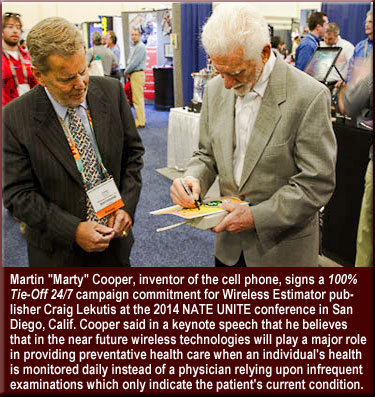 promise to unite the wireless construction industry, but provided a conference that is being recognized as the best event the trade group has ever held. promise to unite the wireless construction industry, but provided a conference that is being recognized as the best event the trade group has ever held.
NATE Unite 2014, according to attendees, was a finely orchestrated event that provided numerous packed educational sessions, networking events and a sold-out exhibit hall.
With a near record number of attendees, the almost 1,400 registrant-mix this year saw an increased percentage of top company management, but noticeably present this year were major carrier representatives and state and federal government officials, from the Occupational Safety and Health Administration to the Department of Defense and the Department of Transportation.
Attendees were also impressed by the multi-track educational presentations.
Whereas trade show sessions can sometimes be weighted with company or product pitches, this year’s presentations were all well-prepared, informative and engaging sessions that allowed everyone to return to their company with tools to make it more productive and profitable; but most importantly, to be able to embrace a safer workforce.
During a keynote video presentation, Assistant Secretary of Labor Dr. David Michaels said that OSHA was close to revising the industry’s riding the line standard to reflect that riding the line will be permissible while performing installations, modifications and  maintenance on elevated structures. maintenance on elevated structures.
When NATE authored the current regulation their intention was to allow riding the line while performing all disciplines of work. However, the final compliance directive authorized the practice only on new structure erections.
Many tower crews currently ride the line while performing work that would not be considered new construction, but OSHA has never cited a company for the practice if they are carefully following the standard.
However, NATE wants to ensure that the CPL’s language is changed to make it permissible and allow for workers to avoid repetitive strain injuries, a common concern in an aging workforce.
Also, few, if any, professions require the physical exertion and stamina that is required of a tower technician making multiple climbs up a tower, weighted down by tools, fall protection equipment and oftentimes structure or transmitting equipment.
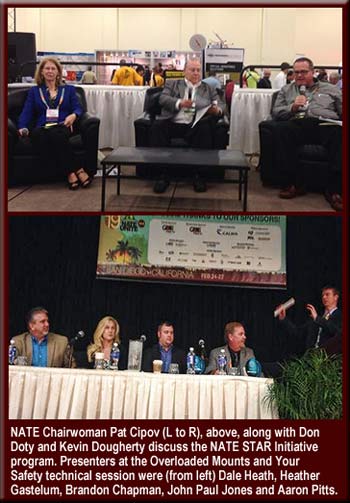 OSHA’s aware of this and realizes that fatigue can easily contribute to 15-20% of fatal accidents caused by human error. OSHA’s aware of this and realizes that fatigue can easily contribute to 15-20% of fatal accidents caused by human error.
Martin “Marty” Cooper, who put a team together at Motorola and invented the first hand-held cell phone, received numerous standing ovations during a packed luncheon keynote speech when he lauded the wireless construction industry for helping to provide the backbone required to enable all mobile devices to work.
Cooper’s enthusiasm for where technology will take us in the future equaled the same upbeat energy shared by everyone during the show.
Many thousands of hours are dedicated to this event by NATE’s staff and the association’s members. But it’s not their time that made this show the huge success that it was, but their talent – coupled with a passionate drive to unite the industry to ensure that the next time it is singled out by the head of OSHA it’s because of its remarkable reduction in accidents and fatalities.
NATE’s staff is already aiming to shatter its attendance record at next year’s 20th anniversary celebration at NATE UNITE 2015 in Orlando, Fla. The smart money says they will.
|
 |
|